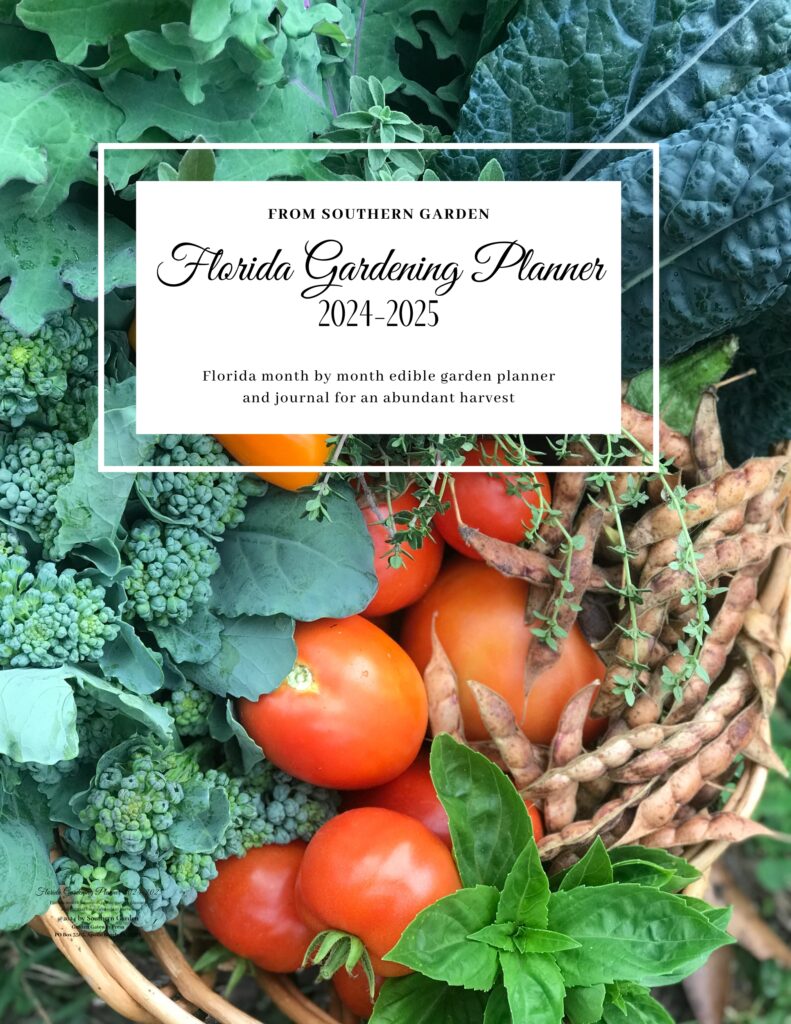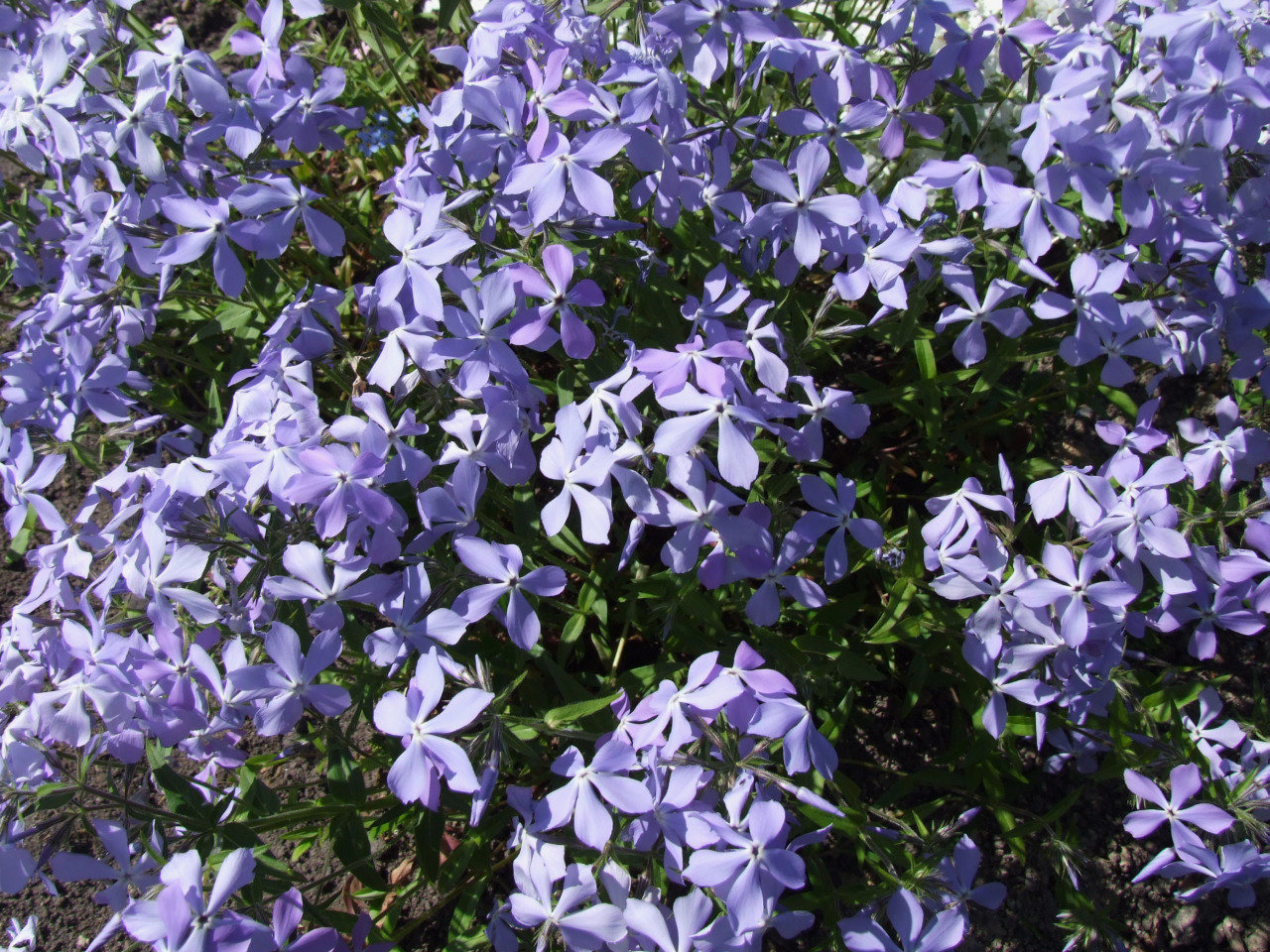
Florida’s unique climate and ecosystem make it a paradise for gardeners, but creating a thriving garden here requires careful plant selection. Florida native plants, particularly groundcovers, offer Sunshine State gardeners an opportunity to create beautiful, sustainable landscapes that thrive in our challenging conditions while supporting local wildlife and reducing maintenance needs.
Here’s my quick and dirty guide to the best Florida native groundcovers for your landscape.
The Power of Florida Native Groundcovers
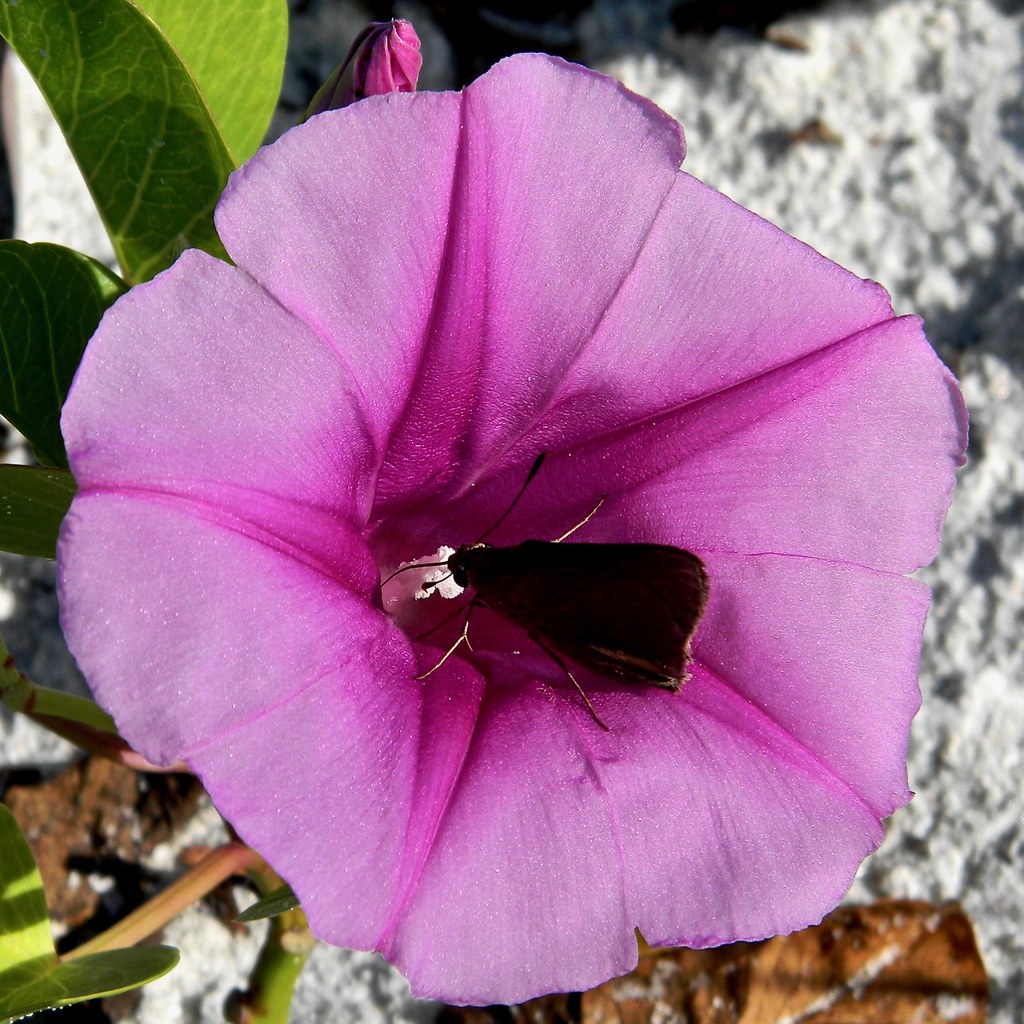
Groundcovers serve as the foundation of a well-designed Florida garden, offering multiple benefits that go far beyond mere aesthetics. These low-growing plants create living mulch that protects and enriches your soil while reducing maintenance needs.
In Florida’s intense climate, groundcovers help regulate soil temperature and moisture, creating more stable growing conditions for all your plants. They also prevent soil erosion during our heavy rains and help suppress weed growth, reducing the time you spend on garden maintenance.
Our Favorite 15 Florida Native Groundcovers for Your Garden
If you’re looking for the best Florida native groundcovers for your landscaping, here’s a list of the top choices. Some will be best for the cooler region of North Florida, while others will prefer the hot, sunny southern region of the state.
Make sure you check each plant’s preferred growing conditions to ensure that your Florida native groundcovers remain low maintenance for years to come.
1. Wild Blue Phlox (Phlox divaricata)
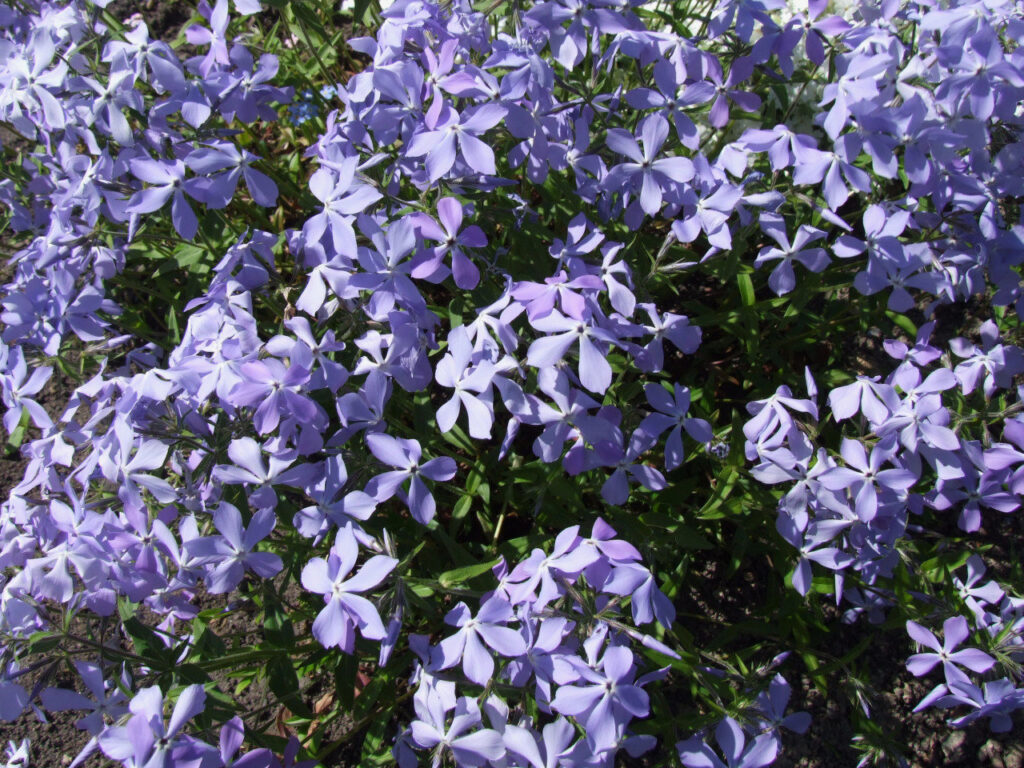
Wild blue phlox is a perennial herbaceous plant with fragrant, delicate blue or lavender flowers that bloom in loose clusters. The flowers have five petals each, forming a star-like shape, and the plant has a soft, spreading growth habit. The leaves are opposite and lance-shaped, giving the plant a bushy appearance.
Wild blue phlox is a low-maintenance plant that is often found in woodland or meadow settings. Its beauty and pleasant fragrance make it a popular choice for naturalized gardens or as an underplanting in shady areas.
Best Growing Region / Zone
Wild blue phlox is well-suited to USDA hardiness zones 4 to 8, which encompasses much of the northern and central United States, extending into parts of the Southeast. It grows particularly well in moist, shaded areas and is common in the woodlands of eastern North America. It’s a favorite for Florida native ground cover in shade gardens.
Wild Blue Phlox Preferred Growing Conditions
This plant thrives in moist, well-drained soil that is rich in organic matter. It prefers partial to full shade, making it an ideal choice for woodland gardens or areas with dappled sunlight.
Wild blue phlox also tolerates some sunlight but performs best in cooler, shaded conditions. It appreciates consistent moisture, especially during the blooming period, and should be watered regularly to avoid dry spells.
Height / Spread
Wild blue phlox grows to a height of 12 to 18 inches and spreads up to 18 inches wide. Its compact, spreading growth habit makes it suitable for use in ground covers or as a low border in garden beds.
Wild blue phlox Lifespan
As a perennial, wild blue phlox returns year after year, typically living for several seasons with minimal care. It is a reliable addition to any garden, particularly in shady or woodland environments, where it thrives and naturalizes over time.
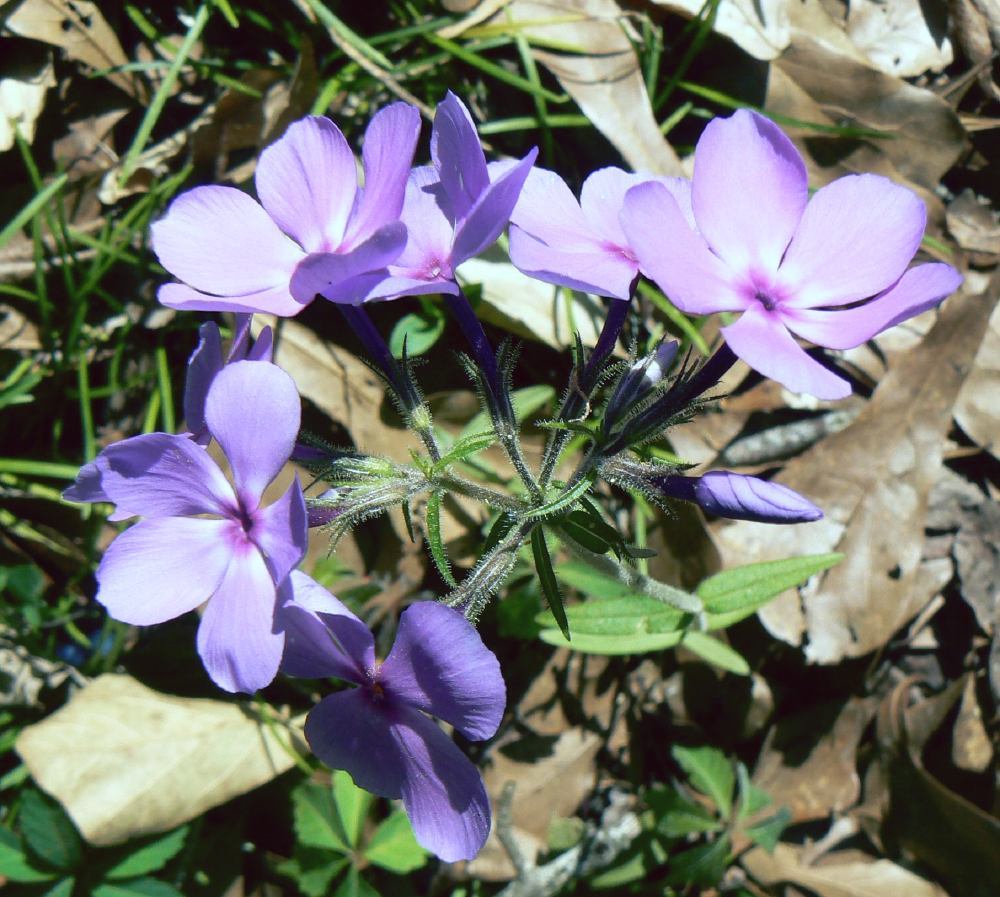
Bloom Period
The bloom period for wild blue phlox is in spring, typically from April to June, depending on the climate. The plant produces abundant clusters of small, tubular flowers that last for several weeks, providing an early source of nectar for pollinators.
Flower Color
The flowers of wild blue phlox are typically shades of pale to medium blue or lavender, with a slight pinkish hue in some varieties. The five-petaled flowers have a star-like shape and a pleasant fragrance that attracts pollinators.
Wildlife Value
Wild blue phlox is an excellent plant for attracting a variety of pollinators, including bees such as the Common Eastern Bumblebee (Bombus impatiens) and butterflies like the Spring Azure (Celastrina ladon) and Fritillary species.
Its early blooming period provides important nectar sources for these insects, particularly in areas where few other plants are in bloom. Additionally, it serves as a host plant for several species of caterpillars, making it beneficial for the broader ecosystem.
2. Sunshine Mimosa (Mimosa strigillosa)
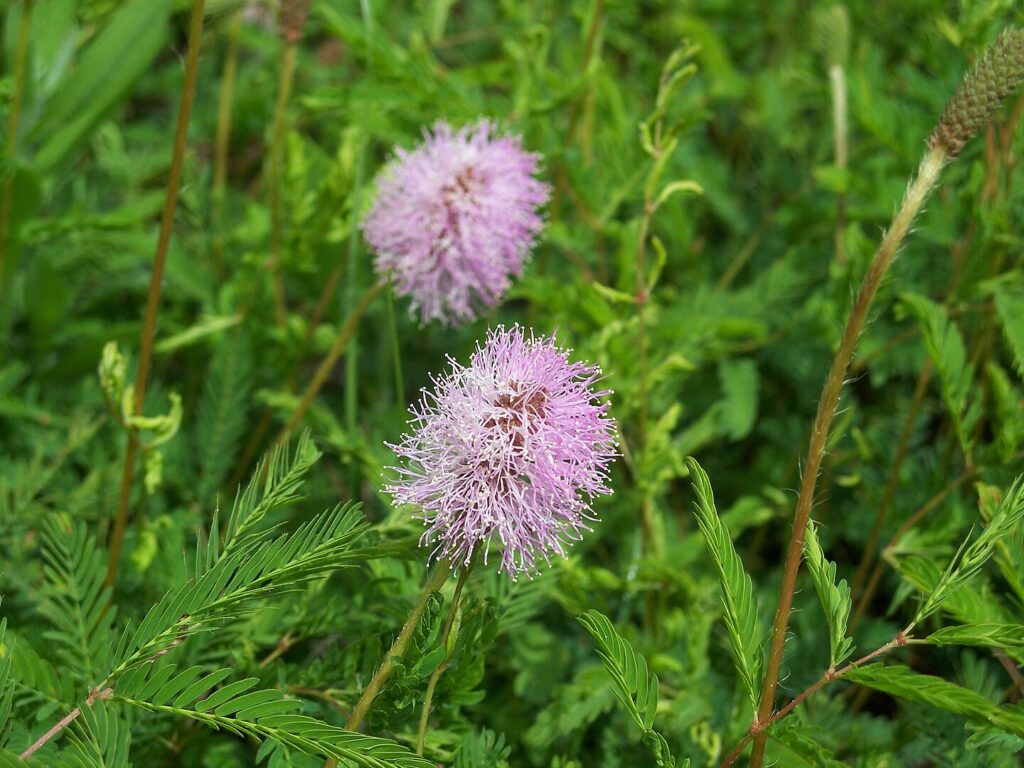
Sunshine Mimosa is one of the most popular Florida native groundcover. It’s a low-growing, spreading perennial that forms a dense mat of foliage. The plant has finely divided, soft, and feathery leaves, which are a characteristic feature. It produces small, pink, ball-shaped flowers, which are highly attractive to pollinators, particularly bees and butterflies.
Sunshine Mimosa is known for its ability to thrive in a variety of soil types, including sandy and dry conditions. The plant’s spreading habit allows it to form a natural ground cover, making it ideal for stabilizing soil and suppressing weeds in gardens and landscapes.
Best Growing Region / Zone
Sunshine Mimosa is well-suited for Florida’s climate, thriving in USDA hardiness zones 8a to 11. It is commonly found in well-drained soils, such as those in sandy uplands, and is especially popular in the central and southern parts of Florida.
Its ability to tolerate the warm and humid conditions of the state makes it a valuable plant for groundcover in Florida landscapes. It’s flexible as a groundcover for both sunny spots and shade.
Sunshine Mimosa Preferred Growing Conditions
This plant thrives in full sun to partial shade. It is drought-tolerant once established, making it a great option for xeriscaping and areas where water conservation is important. Sunshine Mimosa does best in well-drained, sandy, or loamy soils but is adaptable to a range of soil types.
It can tolerate some dry conditions, though it will perform better with occasional watering, especially during prolonged dry periods. It does not require regular fertilization but can benefit from occasional organic matter additions to improve soil fertility.
Height / Spread
Sunshine Mimosa typically grows to about 6 to 8 inches in height but can spread up to 2 to 3 feet wide. Its low, mat-forming growth habit makes it an excellent groundcover plant. It tends to spread quickly by producing runners that root at the nodes, allowing it to form dense patches.
Sunshine Mimosa Lifespan
This is a perennial plant in Florida, meaning it can live for several years, typically continuing to spread and regenerate each year from its root system. It may undergo some dieback during colder months, but it reliably regrows in spring.

Bloom Period
Sunshine Mimosa blooms from late spring to early summer, with its peak bloom occurring in late spring. This Florida native groundcover produces small, pink, pom-pom-like flowers that attract pollinators throughout the bloom period.
Sunshine Mimosa Flower Color
The flowers are soft pink with a ball-shaped structure, consisting of numerous small petals that form a round cluster. These flowers are very attractive to bees, butterflies, and other pollinators.
Wildlife Value
Sunshine Mimosa provides excellent wildlife value, particularly for pollinators. The flowers are highly attractive to bees, including native species such as the southeastern blueberry bee (Habropoda laboriosa) and butterflies, including the common buckeye (Junonia coenia) and the Gulf fritillary (Dione juno).
Its dense growth habit also provides cover for small wildlife, and its seeds are sometimes consumed by birds.
3. Frogfruit (Phyla nodiflora)

Frogfruit is one of my favorite Florida native groundcovers. It’s a low-growing, spreading perennial that forms a dense, mat-like ground cover. I love watching as swarms of bees float over the tops of these strange little flowers.
It has small, bright green, ovate leaves and produces clusters of tiny, white to purple flowers. Frogfruit is often found in coastal and upland habitats, thriving in disturbed soils, roadsides, and sandy areas. It is a fast-spreading plant, with stems that root at the nodes to create dense patches.
Known for its drought tolerance and ability to grow in poor soils, Frogfruit is an excellent choice for groundcover, providing erosion control and weed suppression.
Best Growing Region / Zone
Frogfruit is well-suited for Florida, thriving in USDA hardiness zones 8a to 11. It is found in a variety of habitats throughout Florida, including coastal regions, roadsides, and disturbed upland areas. Its adaptability to different soil types and conditions makes it a valuable plant for many regions within the state, particularly in the central and southern areas.
Frogfruit Preferred Growing Conditions
This plant thrives in full sun but can tolerate light shade, especially in hotter areas of Florida. It is highly tolerant of drought and poor soil conditions, making it a great option for xeriscaping and low-maintenance landscapes.
Frogfruit prefers well-drained soils but can grow in sandy, loamy, or clay soils. It is also tolerant of salt, making it a suitable choice for coastal landscapes. Once established, it requires minimal water, although it can benefit from occasional irrigation during dry spells.
Frogfruit Height / Spread
Frogfruit typically grows to about 6 to 12 inches in height and spreads up to 3 feet wide. Its spreading growth habit allows it to form a dense mat, making it ideal for ground cover, soil stabilization, and erosion control in both natural and landscaped areas.
Lifespan
Frogfruit is a perennial in Florida, meaning it can live for several years. It tends to spread vigorously each year from its root system and does not require replanting, making it a low-maintenance groundcover option. It can experience dieback during cooler weather but will regenerate in spring.
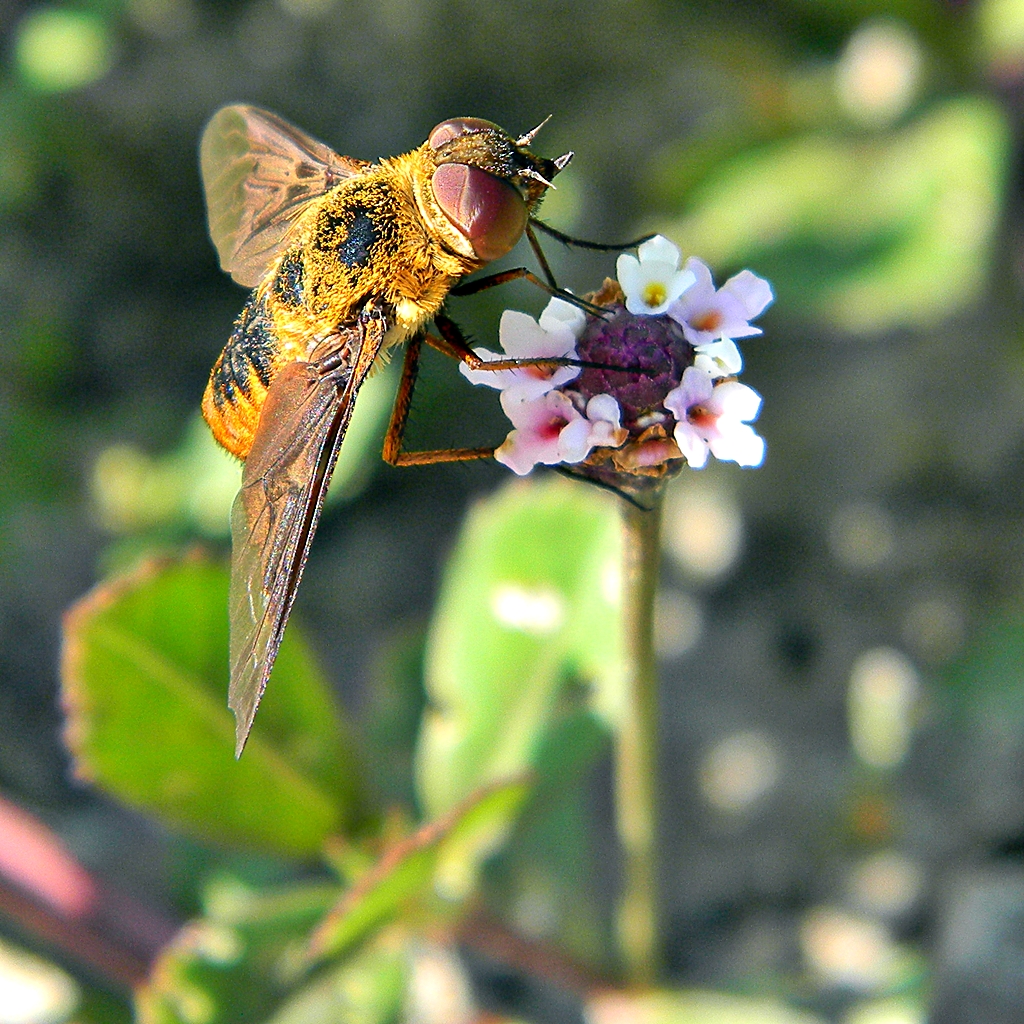
Bloom Period
Frogfruit blooms from late spring through fall, with its peak bloom occurring in summer. The tiny flowers, which are borne in clusters, attract pollinators throughout the growing season.
Frogfruit Flower Color
The flowers are small, white to pale purple, with a star-shaped appearance. They are gathered in dense clusters, forming a characteristic “ball” shape that is attractive to bees, butterflies, and other pollinators.
Wildlife Value
Frogfruit is an excellent plant for attracting pollinators, including a variety of native bee species such as the southeastern blueberry bee (Habropoda laboriosa) and butterflies like the common buckeye (Junonia coenia) and the Gulf fritillary (Dione juno).
It also provides shelter for small wildlife and offers food for seed-eating birds. The plant plays an important role in supporting local ecosystems, particularly in coastal areas. Here on the Gulf Coast, it’s often misidentified as a weed, but in fact, is a critical plant for wildlife forage.
4. Railroad Vine (Ipomoea pes-caprae)
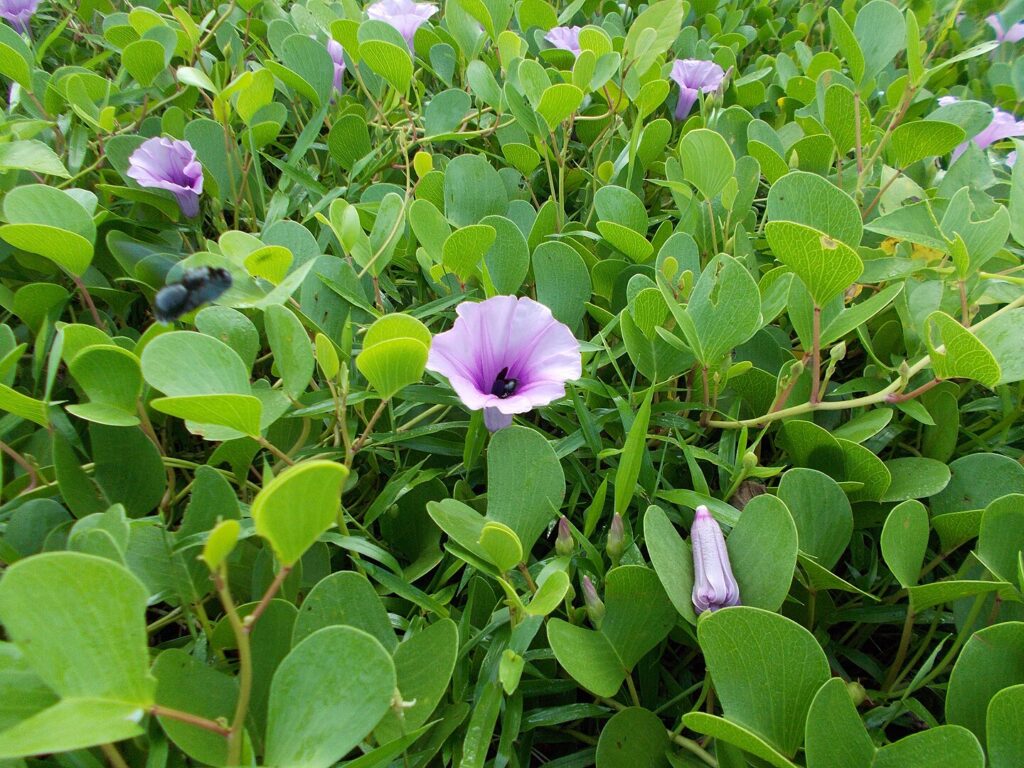
Railroad Vine — or Beach Morning Glory — is a fast-growing, sprawling perennial vine that thrives in sandy coastal soils. It features large, glossy, heart-shaped leaves and produces showy, funnel-shaped flowers in vibrant shades of purple to pink.
The plant is known for its thick, trailing stems, which root at the nodes, allowing it to spread rapidly and form dense mats. Railroad Vine is well adapted to coastal environments, tolerating salt and drought while providing excellent erosion control along dunes and beaches. It is one of the key Florida native groundcovers for stabilizing sandy soils and preventing erosion in coastal landscapes.
Best Growing Region / Zone
Railroad Vine is best suited for Florida’s coastal regions, thriving in USDA hardiness zones 9a to 11. It is commonly found in sandy coastal habitats, including beaches, dunes, and roadsides. The plant is well adapted to Florida’s warm, humid climate, especially in areas near the coast.
Railroad Vine Preferred Growing Conditions
This plant prefers sunny, well-drained, sandy soils but is highly tolerant of various soil types. It thrives in coastal areas that experience occasional saltwater exposure and is a great Florida native groundcover for full sun. It’s also drought-tolerant once established.
Railroad Vine can handle a range of conditions, including sandy, loamy, and even compacted soils, making it perfect for coastal landscaping, erosion control, and groundcover. While it does well with little care, it can benefit from periodic watering during dry periods, particularly in areas that receive limited rainfall.
Height / Spread
Railroad Vine is a sprawling plant that typically grows to 1 to 2 feet in height but can spread up to 10 feet wide or more. Its long, trailing vines root at the nodes, making it ideal for groundcover, beach stabilization, and areas where a fast-growing spread is desired.
Lifespan
Railroad Vine is a perennial in Florida, typically living for several years. It is well-suited for coastal landscapes, where it can form thick, enduring mats. While it can experience dieback during colder weather, it quickly regrows in spring, continuing to spread and stabilize sandy areas.
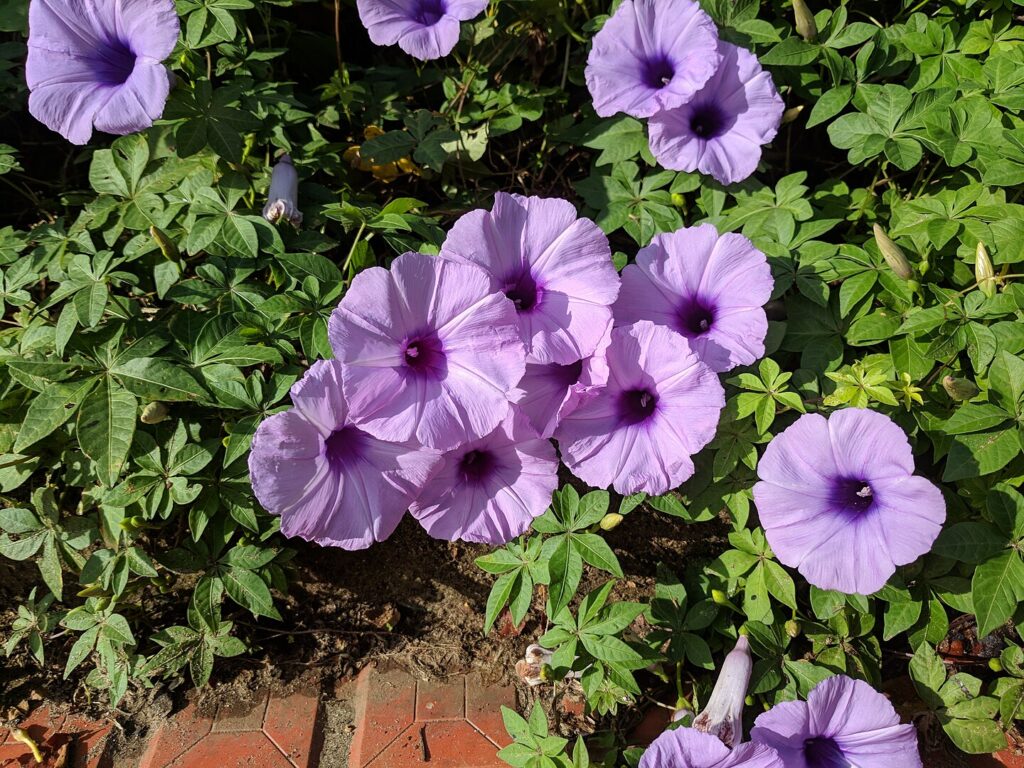
Bloom Period
Railroad Vine blooms from late spring through the fall, with its peak bloom in summer. The plant produces an abundance of large, funnel-shaped flowers that open in the early morning, attracting pollinators throughout its blooming season.
Railroad Vine Flower Color
The flowers are vibrant purple to pink, with a characteristic funnel shape that is about 2 to 3 inches in diameter. The petals often have a lighter, almost white center, adding to the striking appearance of the bloom. These flowers are particularly attractive to bees and butterflies.
Wildlife Value
Railroad Vine provides valuable nectar to pollinators, including native bees and butterflies such as the Gulf fritillary (Dione juno) and the monarch butterfly (Danaus plexippus).
The plant’s dense growth habit offers shelter and habitat for small wildlife, such as birds and insects, while its seeds are consumed by seed-eating birds. Additionally, it is a critical plant for stabilizing coastal ecosystems and preventing sand erosion.
5. Quailberry (Crossopetalum ilicifolium)
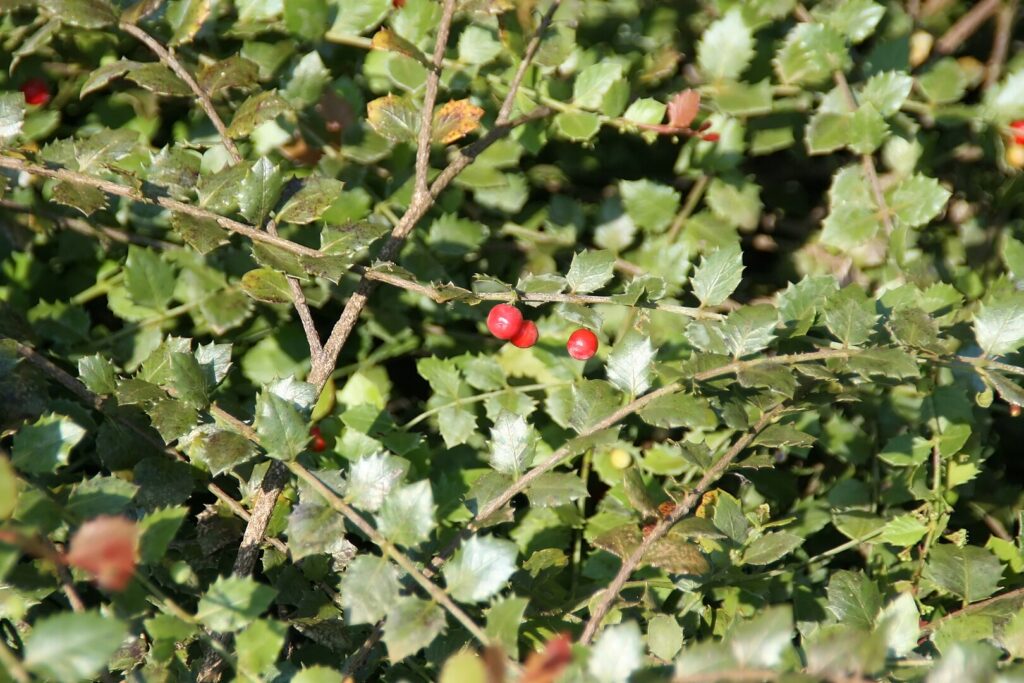
Quailberry is a low-growing, spreading shrub that thrives in Florida’s native habitats, including pinelands, hammocks, and upland areas. It has glossy, dark green, holly-like leaves and produces small clusters of white to cream-colored flowers, followed by distinctive, red berries.
The plant’s compact form and dense branching habit make one of the best Florida native groundcovers for shade or semi-shaded areas. Its attractive foliage and berries also provide visual interest, making it a popular choice for ornamental landscaping in naturalistic gardens.
Best Growing Region / Zone
Quailberry is native to Florida’s central and southern regions and is well-suited to USDA hardiness zones 8b to 11. It is commonly found in natural habitats such as pinelands, sandhills, and mixed hardwood forests throughout the state, particularly in coastal and upland regions.
Preferred Growing Conditions
Quailberry prefers part shade to full shade and thrives in well-drained, acidic, sandy soils. It is well adapted to the often-dry, low-nutrient soils found in Florida’s upland habitats.
The plant tolerates drought once established, though it benefits from regular watering during prolonged dry periods. It is not particularly fussy about soil texture and can adapt to a variety of conditions, from sandy soils to loamy mixes.
Height / Spread
Quailberry is a low-growing shrub that typically reaches 1 to 2 feet in height and spreads up to 3 feet wide. Its spreading habit and dense growth make it an excellent choice for groundcover or as a small-scale border plant in shaded or partially shaded areas.
Lifespan
Quailberry is a perennial shrub in Florida and can live for many years if planted in suitable conditions. It may experience some dieback during extreme cold spells, but it generally regrows from its root system, maintaining a consistent groundcover presence.
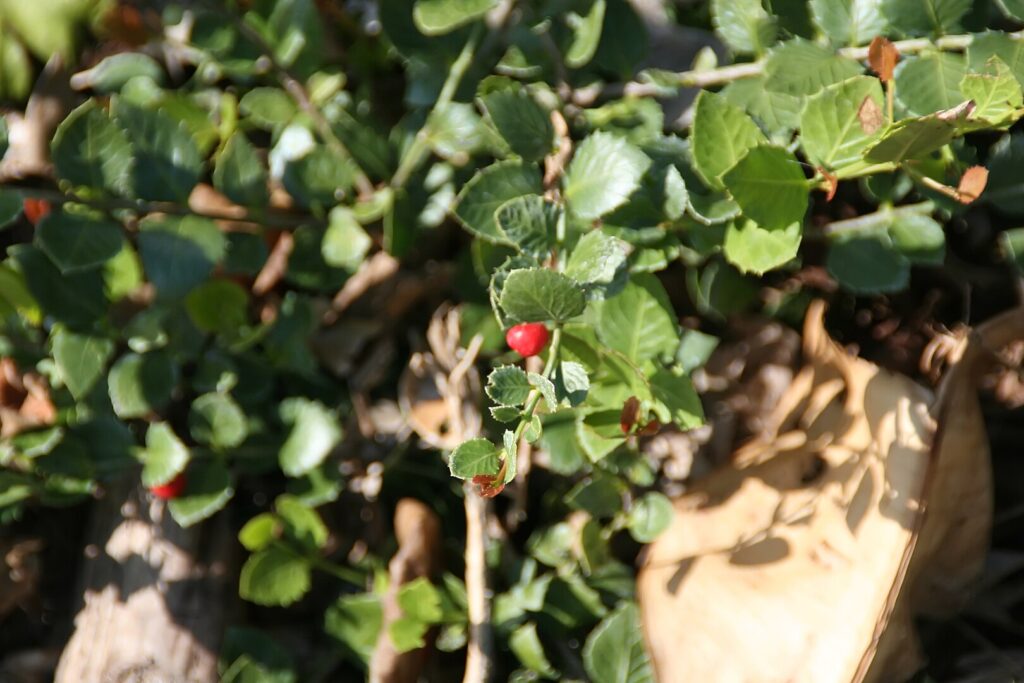
Bloom Period
Quailberry blooms from late spring to early summer, with the peak bloom occurring in late May and June. Its small white to cream-colored flowers are grouped in clusters, providing an appealing contrast to the plant’s glossy green leaves. The flowers attract small pollinators like bees.
Quailberry Flower Color
The flowers are small and white to cream in color, often tinged with a pale yellow hue. They grow in clusters, forming a delicate display that contrasts beautifully with the dark green foliage.
Wildlife Value
Quailberry offers excellent value to wildlife. The plant’s flowers attract pollinators, including native bees and butterflies, while its red berries provide food for birds such as quail, wood thrushes, and other seed-eating species.
The dense, evergreen foliage also provides shelter for small mammals and insects, supporting a diverse range of wildlife. The plant is an important component of Florida’s natural ecosystems, offering food and habitat to various species throughout the year.
6. Porterweed (Stachytarpheta jamaicensis)
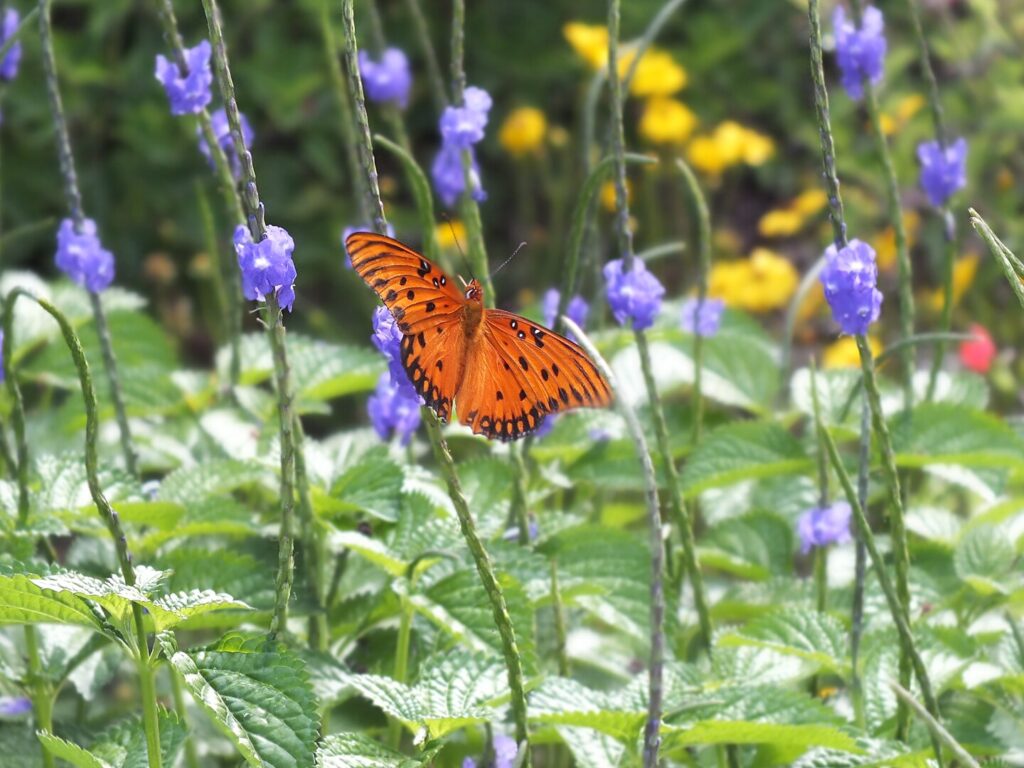
Porterweed is a fast-growing, herbaceous perennial that is often found in coastal areas, roadsides, and disturbed sites. It has striking, dark green leaves and produces vibrant, long spikes of tubular purple or blue flowers, which bloom intermittently throughout the year.
The plant’s growth habit makes it one of the more attractive Florida native groundcovers. It can grow up to 3 feet tall in the right conditions, with a spread of about 3 feet. Known for its resilience, Porterweed can tolerate a variety of soil types, including poor, sandy, or clayey soils.
Best Growing Region / Zone
Porterweed is ideal for Florida’s warmer regions, thriving in USDA hardiness zones 9b to 11. It is common throughout the state, particularly in coastal areas, roadsides, and disturbed landscapes. It grows well in areas that experience full sun, but it can also tolerate partial shade.
Porterweed Preferred Growing Conditions
This plant is adaptable, thriving in a range of soil types, including sandy, loamy, and clay soils. Porterweed prefers full sun to part shade and can handle dry spells once established, though it will benefit from periodic watering, especially during extended dry periods.
While it is fairly drought-tolerant, it performs best with regular moisture. Porterweed is also salt-tolerant, making it a good choice for coastal or near-coastal areas.
Height / Spread
Porterweed can grow to a height of 3 feet, making it one of the more flexible of the Florida native groundcovers. It spreads about 3 feet, making it an ideal choice for filling spaces in gardens or naturalized landscapes. Its upright growth habit allows it to fill in areas effectively, especially in mixed plantings.
Lifespan
Porterweed is a perennial in Florida, typically living for several years when grown in favorable conditions. It may die back slightly in colder months, but it usually regrows from its root system in the spring, especially in Florida’s mild winters.

Bloom Period
Porterweed has a long bloom period, producing flowers year-round, with peak bloom in late spring and summer. Its long flower spikes of purple or blue tubular flowers make a colorful addition to landscapes throughout its growing season.
Porterweed Flower Color
The flowers are tubular, deep purple or blue, and grow in elongated spikes. The vibrant color makes this plant a popular choice for attracting pollinators, and its flowers stand out in coastal and garden settings.
Wildlife Value
Porterweed is a valuable plant for pollinators, particularly attracting hummingbirds, butterflies, and bees. The long, tubular flowers are particularly appealing to species such as the Ruby-throated Hummingbird (Archilochus colubris) and butterflies like the Common Buckeye (Junonia coenia) and the Gulf Fritillary (Dione juno).
The plant also provides shelter to small insects, making it an important contributor to supporting a diverse wildlife community in gardens and naturalized areas.
7. Sea Purslane (Sesuvium portulacastrum)
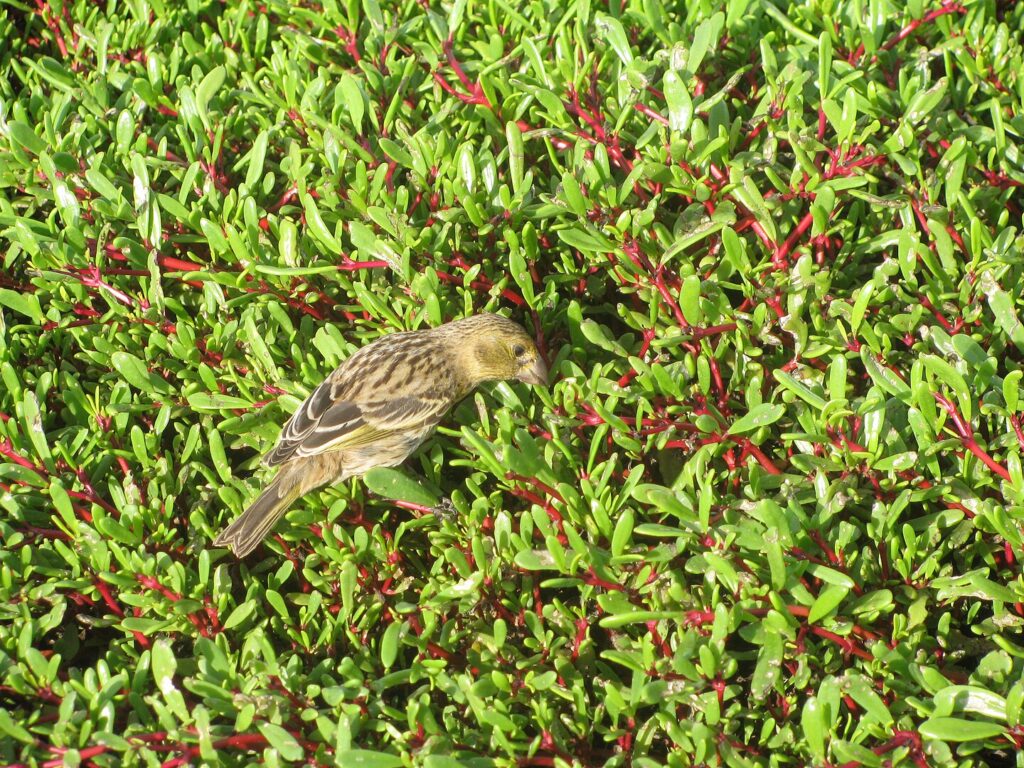
Sea Purslane is a low-growing, spreading succulent groundcover that thrives in coastal habitats and salt-tolerant environments. It has fleshy, succulent leaves that are green to reddish, and its small, vibrant pink to purple flowers bloom sporadically throughout the year.
The plant is typically found along beaches, dunes, and coastal flats, where it plays an important role in stabilizing soil and preventing erosion. Its ability to withstand saltwater exposure and drought conditions makes it a reliable choice for coastal landscaping.
Best Growing Region / Zone
Sea Purslane is well-suited for Florida’s coastal regions, thriving in USDA hardiness zones 9b to 11. It is commonly found in sandy, well-drained soils along beaches, dunes, and coastal flats throughout Florida, particularly in areas exposed to saltwater and sea breezes.
Sea Purslane Preferred Growing Conditions
This plant thrives in full sun and well-drained, sandy or salty soils. Sea Purslane is highly tolerant of both saltwater and drought, making it ideal for coastal environments. It’s my top choice for Florida native groundcovers for full sun exposure in coastal areas.
It can withstand the occasional spray of saltwater and does not require frequent irrigation once established. It grows best in areas where the soil is well-drained but can tolerate periods of dryness. Sea Purslane is a low-maintenance plant that requires minimal care and attention, making it a good choice for low-impact coastal landscaping.
Height / Spread
Sea Purslane grows to a height of 6 to 12 inches and can spread up to 3 feet wide, making it an excellent groundcover or erosion control plant for coastal gardens or naturalized areas. Its spreading habit allows it to cover large areas, making it effective at stabilizing dunes and preventing soil erosion.
Sea Purslane Lifespan
This plant is a perennial in Florida, typically living for several years in coastal conditions. It can tolerate the harsh coastal environment and continues to spread over time, providing long-lasting coverage in gardens and naturalized spaces.
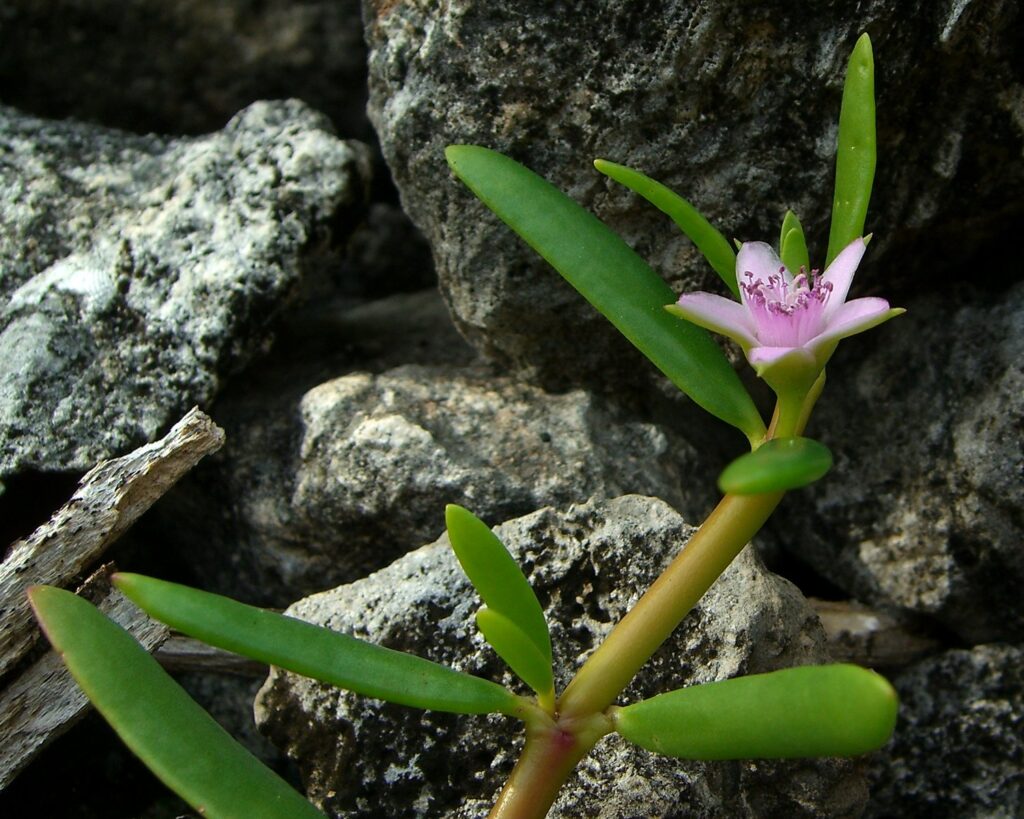
Bloom Period
Sea Purslane blooms intermittently throughout the year, with peak bloom occurring in late spring to summer. The plant produces small, colorful pink to purple flowers that attract pollinators, including bees and butterflies.
Sea Purslane Flower Color
The flowers are small, with pink to purple petals and a yellow center, forming clusters that are attractive to various pollinators. The flowers’ bright color contrasts with the succulent green foliage, adding visual appeal to coastal landscapes.
Wildlife Value
Sea Purslane provides food and shelter for a variety of coastal wildlife. Its flowers attract pollinators, including native bees, butterflies such as the Gulf Fritillary (Dione juno), and other nectar-seeking insects. The plant’s dense foliage also offers shelter for small insects and provides a habitat for coastal birds that seek refuge in its spreading leaves.
The seeds of Sea Purslane may be consumed by certain small birds, adding to its role as a wildlife-supporting groundcover. Additionally, the plant plays a critical ecological role in stabilizing sand dunes, which protects coastal habitats from erosion and supports a variety of other coastal species.
8. Browne’s Savory (Clinopodium brownei)

Browne’s Savory is a low-growing, perennial herb that typically forms dense, spreading clumps. It has square stems and opposite, ovate leaves with a pleasant aromatic scent when crushed. The small, tubular flowers are typically pink to purple and are arranged in loose clusters.
The plant is often found in sandy soils, along roadsides, and in disturbed areas, and it prefers open habitats with full sun to partial shade. Like many Florida native groundcovers, it is notable for its ability to tolerate drought and low-nutrient soils, making it a resilient addition to our fragile landscapes.
Best Growing Region / Zone
Browne’s Savory is well-suited to Florida’s central and northern regions, thriving in USDA hardiness zones 8b to 11. It is typically found in sandy or loamy soils in natural habitats such as dry pinelands, coastal prairies, and roadsides.
Browne’s Savory Preferred Growing Conditions
This groundcover plant prefers well-drained, sandy or loamy soils and benefits from full sun but can tolerate partial shade. It is drought-tolerant once established, making it well-suited for low-maintenance landscapes and naturalized gardens.
Browne’s Savory requires minimal watering and can grow in a variety of soil pH levels, though it performs best in slightly acidic to neutral soils. It can also thrive in nutrient-poor soils, which makes it a hardy choice for Florida’s often sandy conditions.
Height / Spread
Browne’s Savory typically grows to a height of 1 to 2 feet and spreads to about 1 to 2 feet wide. It forms compact, bushy clusters that make it an excellent groundcover or low shrub for garden borders, rock gardens, or native plant landscapes.
Lifespan
Browne’s Savory is a perennial, meaning it will return year after year, especially in well-drained, low-maintenance environments. It can live for several years, particularly when planted in areas that meet its growing requirements.

Browne’s Savory Bloom Period
This plant blooms from late spring to early fall, with its peak bloom typically occurring in summer. The flowers are small, tubular, and tend to cluster in the upper leaf axils, providing continuous color through much of the warm months.
Flower Color
The flowers of Browne’s Savory are usually pink to purple, with a tubular shape. They form clusters at the tips of the stems, adding visual interest and a touch of color to the plant’s foliage.
Wildlife Value
Browne’s Savory supports a range of pollinators, including native bees and butterflies. Its flowers attract pollinators like the Eastern Tiger Swallowtail (Papilio glaucus) and various species of native bees that seek nectar from the small, tubular flowers. Additionally, the plant offers cover and habitat for small insects and beneficial creatures in the landscape.
9. Carolina Ponysfoot (Dichondra carolinensis)
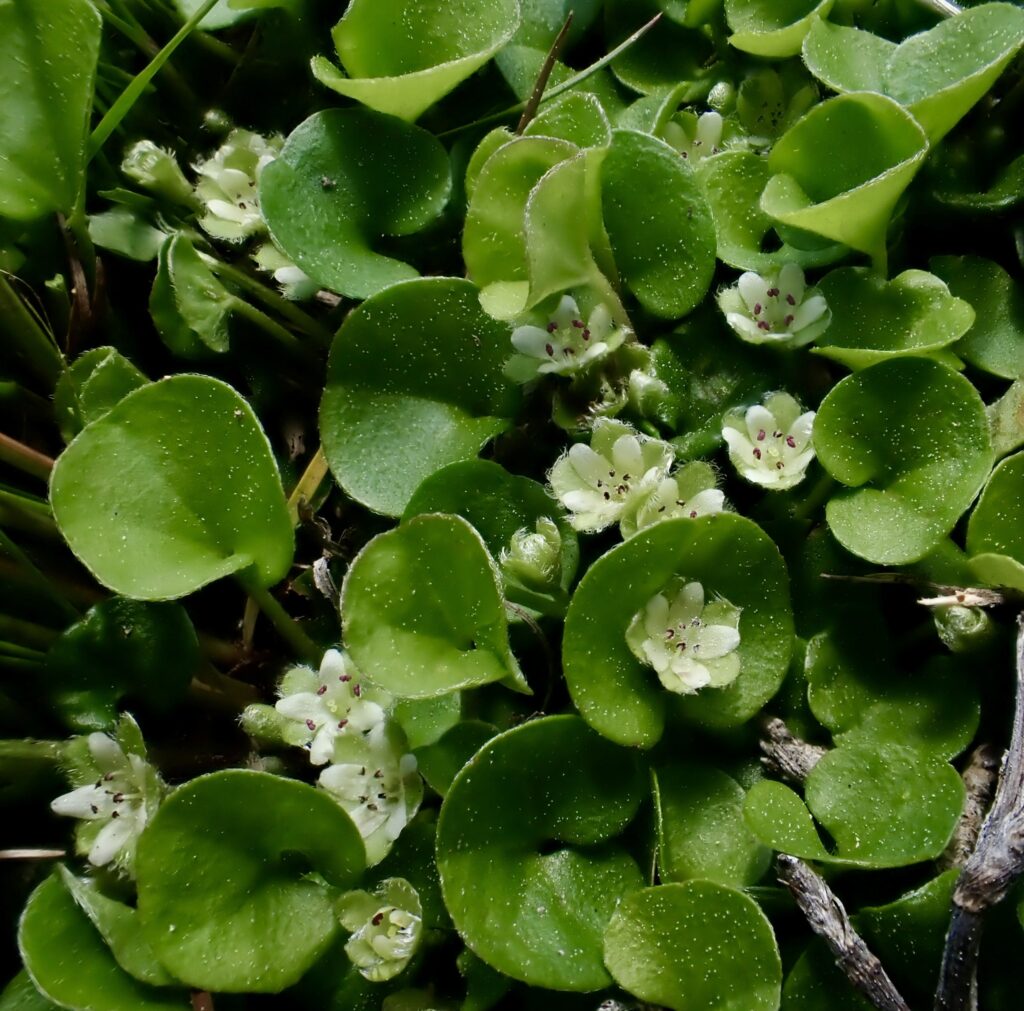
Carolina Ponysfoot is a low-growing, creeping perennial that forms a dense mat of small, rounded, green leaves. The leaves are typically about 1/2 inch across and have a soft, velvety texture.
The plant produces inconspicuous, small, greenish flowers that are not particularly showy, but the real appeal of this species lies in its ability to form a lush, carpet-like ground cover. It thrives in sandy, well-drained soils and is often found in Florida’s coastal and upland habitats, as well as in disturbed areas.
Best Growing Region / Zone
Carolina Ponysfoot is well-suited for Florida’s central and southern regions, thriving in USDA hardiness zones 8b to 11. It can be found in coastal areas, pine flatwoods, and other disturbed habitats across the state.
Carolina Ponysfoot Preferred Growing Conditions
This plant prefers well-drained, sandy to loamy soils and does best in full sun to light shade. It is drought-tolerant once established and can grow in a variety of soil pH levels, but it performs best in slightly acidic to neutral soils.
Carolina Ponysfoot is tolerant of poor soils and has a moderate tolerance for salt, making one of the ideal Florida native groundcovers for coastal gardens or areas exposed to salt spray.
Height / Spread
Carolina Ponysfoot typically grows to a height of 2 to 4 inches and spreads rapidly to form a dense mat that can cover several square feet. Its low growth habit makes it an excellent choice for ground cover in sunny or lightly shaded areas.
Lifespan
Carolina Ponysfoot is a perennial in Florida, continuing to spread and thrive year after year in suitable conditions. It is a hardy groundcover that regenerates from its creeping stems each season.
Carolina Ponysfoot Bloom Period
This plant blooms sporadically throughout the warmer months, typically from late spring to early fall. The flowers are small and not very conspicuous, but they provide an additional layer of interest during the blooming period.
Flower Color
The flowers of Carolina Ponysfoot are small, greenish, and inconspicuous. They are not particularly showy but may appear in clusters at the leaf axils during the warmer months.
Wildlife Value
While Carolina Ponysfoot does not attract many showy pollinators due to its small flowers, it provides an important ground cover for small wildlife. Its dense mat offers shelter and habitat for insects and small critters, including native ants and other beneficial species that thrive in low-growing, shaded environments.
It is not a significant nectar or pollen source for large pollinators but can contribute to a diverse ecosystem in naturalized or low-maintenance gardens.
10. Partridgeberry (Mitchella repens)
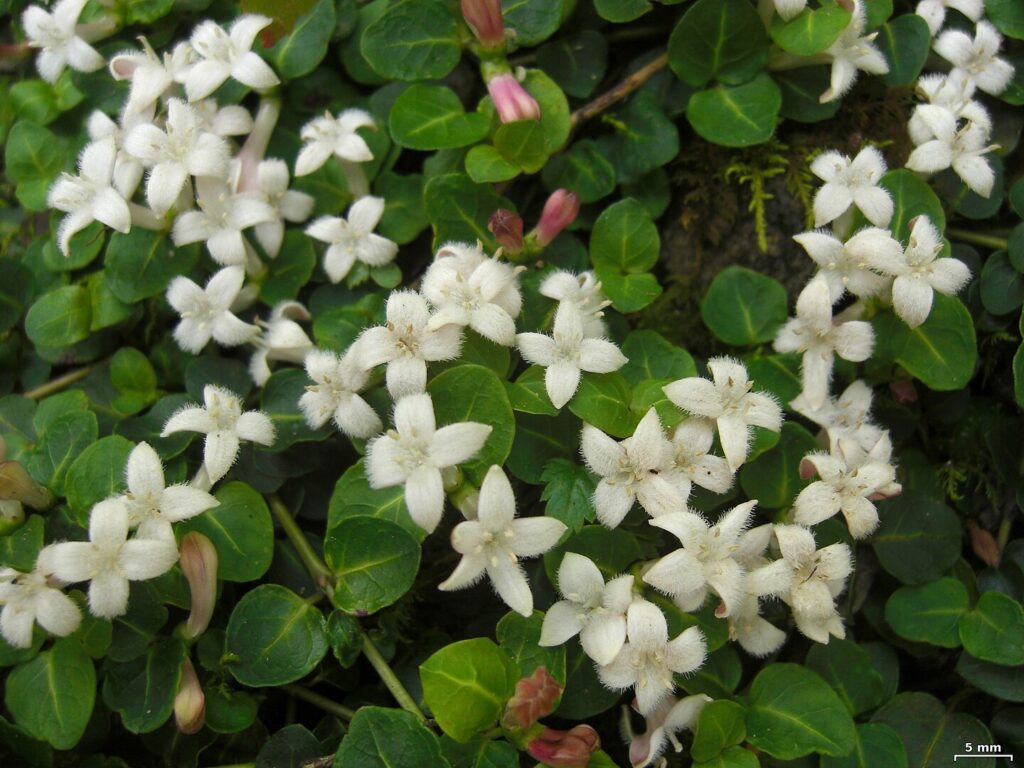
Partridgeberry is a low-growing, evergreen ground cover with distinctive, opposite, oval leaves that are dark green and often marked with lighter veins. The plant forms dense mats with creeping stems that root at the nodes. In late spring to early summer, it produces delicate, paired, white or pinkish flowers that resemble small, tubular bells.
These flowers are often followed by bright red berries in the fall, which are an attractive feature and persist through winter. Partridgeberry thrives in shaded, moist environments and is commonly found in pine forests, woodlands, and other acidic, low-light habitats.
Best Growing Region / Zone
Partridgeberry is native to Florida’s north and central regions, thriving in USDA hardiness zones 8a to 11. It is typically found in shaded forested areas, particularly in the understory of pine and hardwood forests, but can also grow in gardens with the right conditions.
Partridgeberry Preferred Growing Conditions
This plant prefers well-drained, acidic soils that retain moisture but do not become waterlogged. It thrives in partial to full shade, making it one of the best Florida native groundcovers for shaded spots in the garden. Partridgeberry can also tolerate dry periods once established.
It is well-suited for woodland gardens, shaded areas under trees, and along the edges of forest clearings. Partridgeberry is not very drought-tolerant and does best in environments with consistent moisture and cool temperatures.
Height / Spread
Partridgeberry typically grows to a height of 3 to 6 inches and spreads widely, often covering large areas with its creeping stems. Its low-growing habit makes it an excellent ground cover for shaded, woodland environments, especially in areas where taller plants may not thrive.
Lifespan
Partridgeberry is a perennial plant that continues to grow and spread year after year. It is evergreen in its native range and maintains its foliage throughout the year, though it may die back during extreme cold spells in the northern parts of its range.
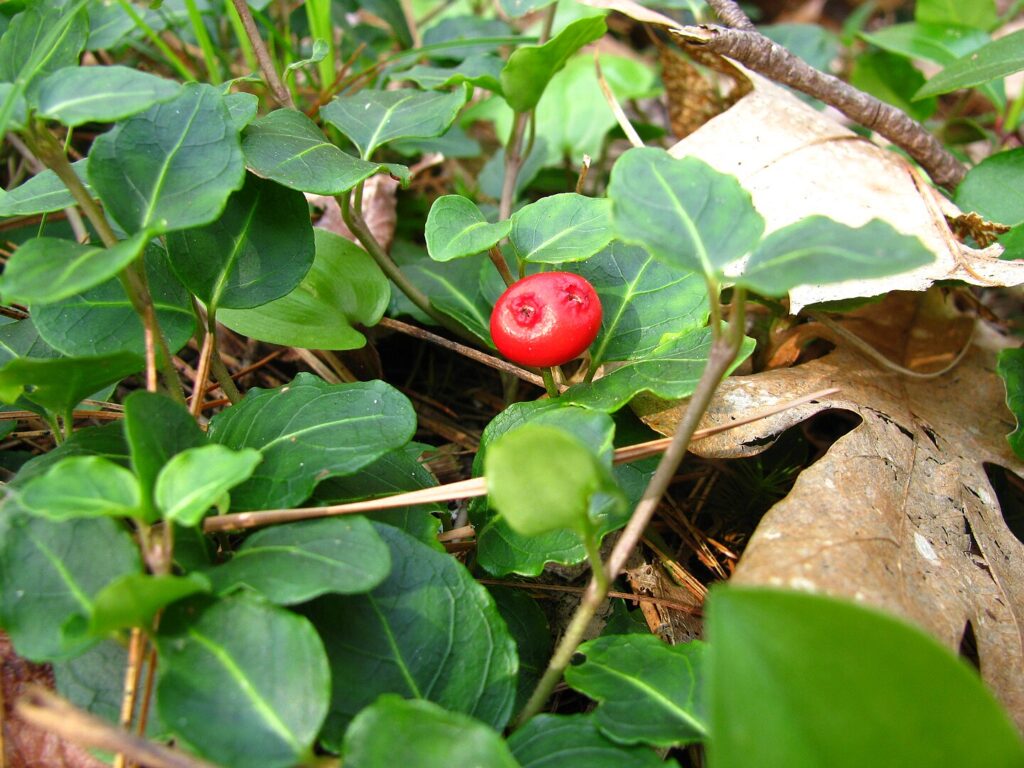
Partridgeberry Bloom Period
The plant blooms in late spring to early summer, typically from May to June, producing small, white or pinkish, tubular flowers in pairs. These flowers are not very showy but are an important food source for some insects.
Partridgeberry Flower Color
The flowers are small and tubular, white or pale pink with five petals, forming in pairs. The flowers appear in the axils of the leaves and are followed by bright red berries.
Wildlife Value
Partridgeberry provides a subtle yet valuable wildlife benefit. Its flowers offer nectar to various small pollinators, such as native bees and ants. The bright red berries are highly attractive to birds, including robins, mockingbirds, and cedar waxwings, which feed on the fruit during the fall and winter months.
The dense mats of foliage also provide shelter and cover for small wildlife, including insects and amphibians. It is a beneficial addition to wildlife gardens where moisture and shade are available.
11. Oblongleaf Twinflower (Dyschoriste oblongifolia)
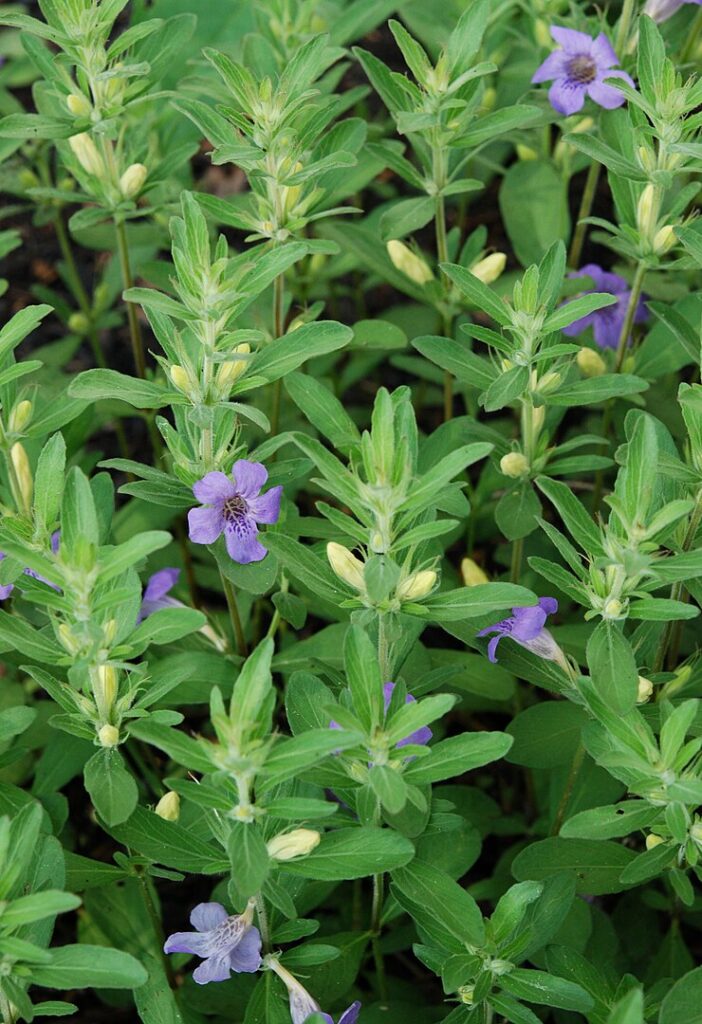
Oblongleaf Twinflower is a low-growing perennial that forms a spreading mat of small, elliptical leaves. The plant produces clusters of tubular, pale lavender to pink flowers with dark purple markings on the lower lobes. These flowers appear at the axils of the leaves in late spring to summer and are visually appealing to both pollinators and gardeners.
The plant has a sprawling habit and can serve as a ground cover in the right conditions. It thrives in well-drained, sandy soils and is often found in pine flatwoods and upland areas in its native range. The leaves are opposite, and the stems are typically slightly hairy.
Best Growing Region / Zone
Oblongleaf Twinflower is found in USDA hardiness zones 8a to 11, primarily in Florida’s central and northern regions. It is adapted to a variety of soil types, particularly those that are sandy, well-drained, and slightly acidic, and is often found in dry to mesic environments like pine flatwoods and upland forests.
Oblongleaf Twinflower Preferred Growing Conditions
This plant thrives in partial to full sun, though it can tolerate some shade in hotter parts of its range. It prefers well-drained soils, particularly sandy or loamy soils, and is somewhat drought-tolerant once established.
Oblongleaf Twinflower does not like waterlogged conditions and will perform best in areas where moisture is consistent but not excessive. While it grows best with regular moisture, it can adapt to drier conditions once established.
Height / Spread
Oblongleaf Twinflower grows to a height of 1 to 2 feet and spreads about 2 feet wide. Its low, spreading habit makes it an excellent ground cover for dry, sandy areas where taller plants may not thrive. The plant may spread even further in favorable conditions.
Oblongleaf Twinflower Lifespan
This plant is a perennial in its native range and will continue to grow year after year in the right conditions. It may die back in the winter months but typically regenerates in the spring.
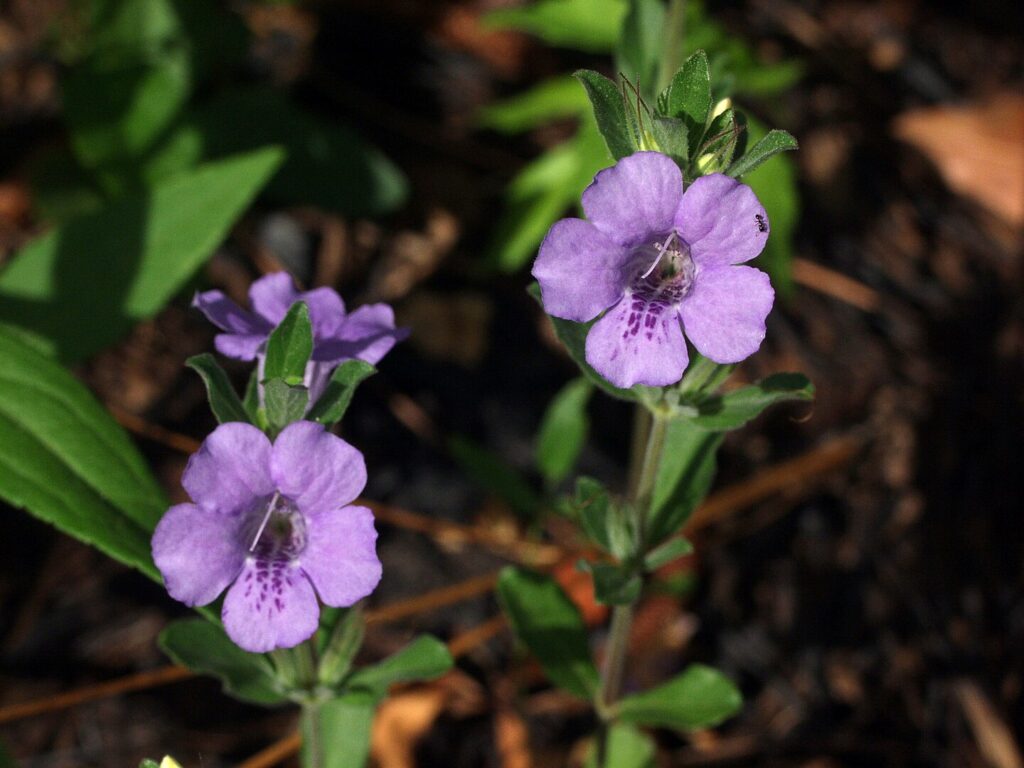
Bloom Period
Oblongleaf Twinflower blooms from late spring through summer, with peak bloom occurring in May and June. Its lavender to pink flowers attract various pollinators, including bees and butterflies. The bloom period can last several months, providing a long window of nectar availability.
Oblongleaf Twinflower Flower Color
The flowers are tubular, pale lavender to pink, with darker purple markings on the lower lobes. The color contrast and the unique structure of the flowers make them appealing to a variety of pollinators.
Wildlife Value
Oblongleaf Twinflower is one of the most valuable Florida native groundcovers for wildlife, providing nectar source for several species of pollinators. Its small, tubular purple flowers attract a variety of bees, including species of native solitary bees and Honeybees (Apis mellifera).
The flowers are also visited by butterflies such as the Gulf Fritillary (Dione juno) and the Common Buckeye (Junonia coenia), which feed on the nectar. While not a primary host plant, its blooms support pollinator diversity, playing a role in the broader ecosystem.
Additionally, the plant provides ground-level cover, which benefits small insects and other wildlife by offering a refuge in the understory.
2. Creeping Woodsorrel (Oxalis corniculata)
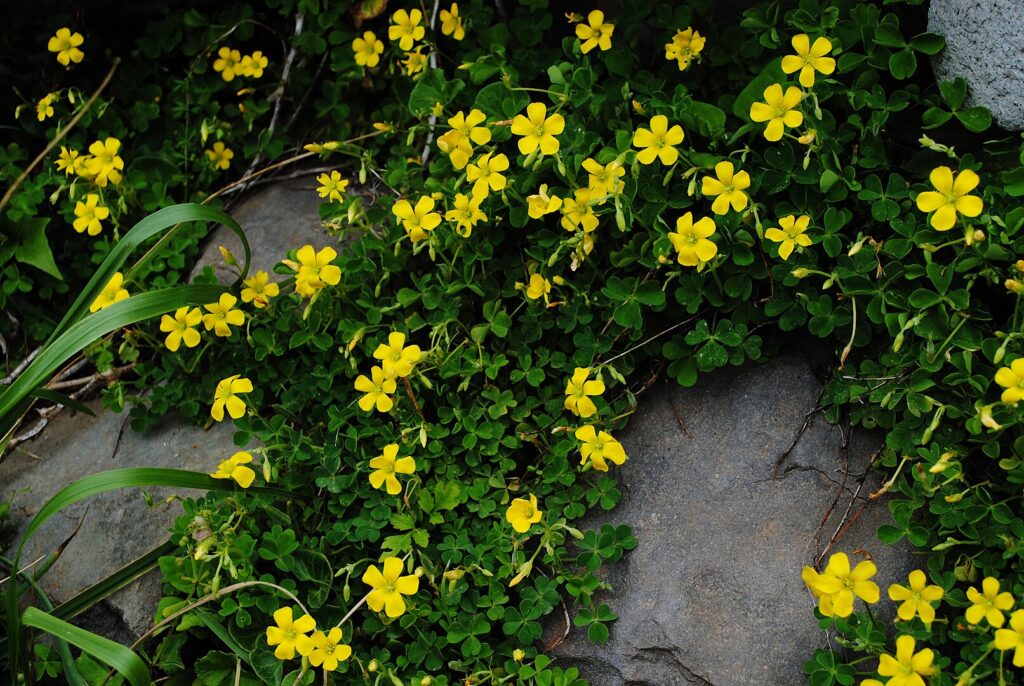
Creeping Woodsorrel is a low-growing perennial groundcover with a spreading habit. It has trifoliate, heart-shaped leaves that are light green and often tinged with reddish hues. The plant produces small, bright yellow flowers that appear in clusters at the leaf axils. These flowers are delicate and have five petals.
Creeping Woodsorrel spreads by both seed and runners, forming a dense mat that can help control soil erosion in disturbed or bare areas. While it is a hardy plant that can thrive in a variety of conditions, it is often considered a weed in gardens due to its tendency to spread rapidly and outcompete other plants.
Best Growing Region / Zone
Creeping Woodsorrel is found in USDA hardiness zones 7a to 11, making it suitable for a wide range of climates in Florida. It thrives in moist, well-drained soils and can be found in lawns, gardens, and disturbed areas across the state. The plant is highly adaptable and can grow in both sunny and partially shaded locations.
Creeping Woodsorrel Preferred Growing Conditions
This plant is tolerant of a range of soil types but performs best in slightly acidic, well-drained soils that are kept consistently moist. Creeping Woodsorrel grows well in full sun but is also quite adaptable to shaded areas.
While it prefers moist conditions, it can tolerate periods of drought once established. It is generally easy to care for but may require some management to prevent it from becoming invasive in garden settings.
Height / Spread
Creeping Woodsorrel typically grows to a height of 6 to 8 inches, with a spread of 1 to 2 feet. Its spreading habit makes it an effective groundcover, though it can become weedy in more cultivated spaces. The plant’s low profile allows it to form dense mats that are ideal for erosion control and filling in gaps between other plants.
Creeping Woodsorrel Lifespan
This plant is a perennial, capable of surviving year-round in Florida’s warm climate. It may die back slightly during the cooler months but generally persists through the year, spreading further as it grows.
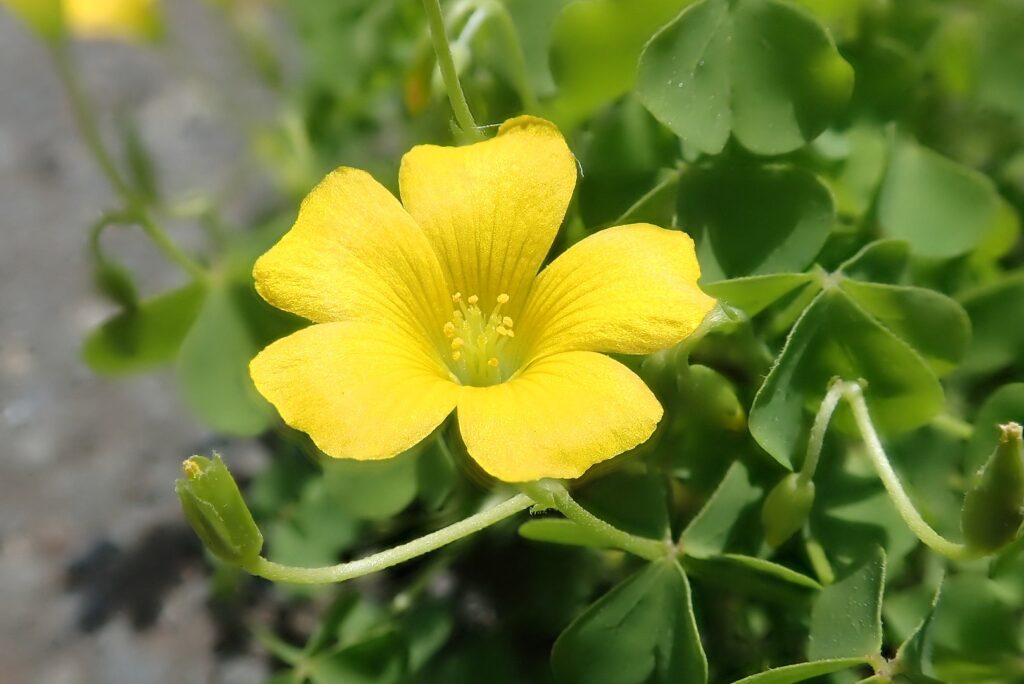
Bloom Period
Creeping Woodsorrel blooms sporadically throughout the year, with the peak bloom occurring in the warmer months, typically from spring through fall. The yellow flowers appear in clusters and are a valuable food source for small pollinators, such as bees.
Creeping Woodsorrel Flower Color
The flowers are bright yellow, about 1 inch across, and typically have five petals. They are delicate and attractive, especially when clustered together in a group.
Wildlife Value
Creeping Woodsorrel supports a variety of pollinators, particularly small bees and other insects that visit its bright yellow flowers for nectar. While the plant does not produce fruit that is eaten by wildlife, its flowers provide an important source of nectar.
It also serves as ground cover, offering some shelter and habitat for small insects and critters. Although not a major wildlife attractor, its role in supporting pollinators makes it valuable for biodiversity.
13. Water Hyssop (Bacopa monnieri)
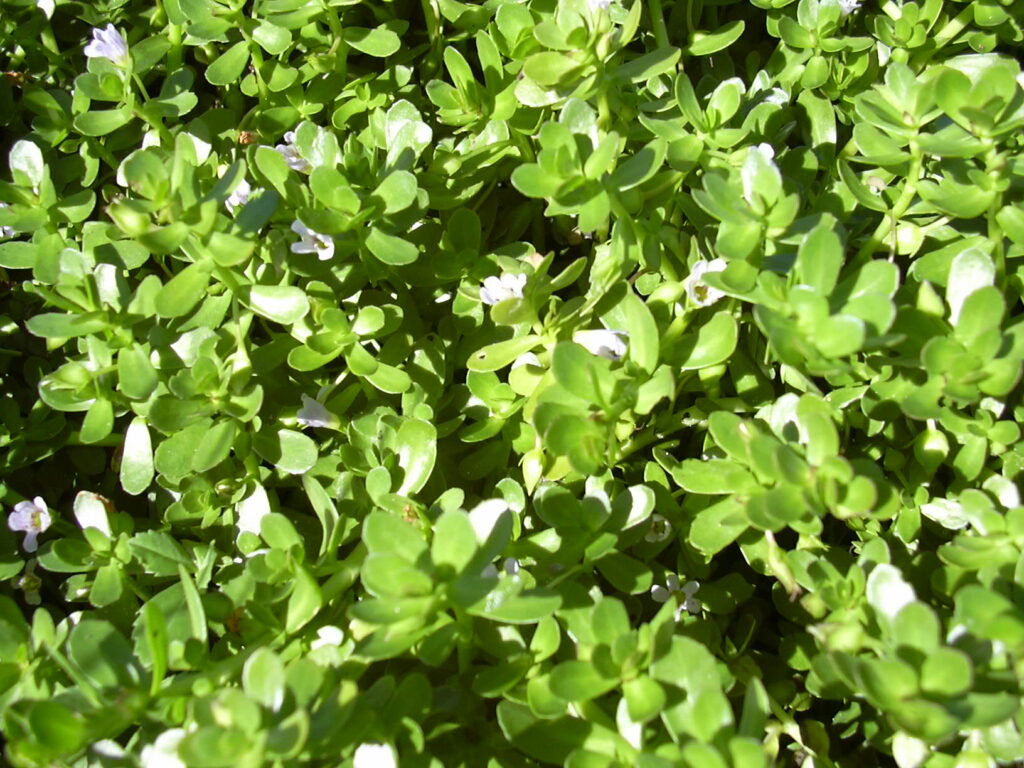
Water Hyssop, or Herb of Grace, is a creeping perennial herb that grows along the edges of shallow water bodies, wetlands, and marshes. It has small, oval-shaped, bright green leaves that are thick and fleshy, giving the plant a succulent appearance. The stems of Water Hyssop are trailing or creeping, often floating or rooting in moist soils.
It produces small, funnel-shaped flowers that are typically light purple to white, with a yellow center. Water Hyssop is often used in water gardens or as a groundcover in wet, boggy areas. It is also known for its medicinal properties, particularly in traditional herbal medicine.
Best Growing Region / Zone
Water Hyssop is well-suited for USDA hardiness zones 8 to 11. It thrives in Florida’s wetlands, marshes, and edges of ponds, streams, and lakes, where it can grow in standing or slow-moving water. The plant is found in moist environments throughout Florida and does particularly well in the warmer regions of the state.
Preferred Growing Conditions
Water Hyssop requires consistently moist conditions, thriving in wet soils and shallow water. It is commonly found in areas with full sun but can tolerate partial shade. The plant prefers slightly acidic to neutral soils but is quite adaptable to different wetland environments.
Water Hyssop benefits from being in areas that remain moist year-round, making it perfect for water garden setups, pond edges, and areas prone to seasonal flooding. It is also tolerant of occasional drought once established but requires supplemental moisture during extended dry periods.
Height / Spread
Water Hyssop typically grows to a height of 6 to 12 inches and spreads outwards by creeping stems, which can cover an area 2 to 3 feet wide. Its spreading habit makes it an excellent choice for covering wet soil or edges of water features in the garden.
Water Hyssop Lifespan
This plant is a perennial in Florida, surviving year-round in wetlands and boggy areas. It will continue to grow and spread each year, returning after any seasonal dieback during colder months.
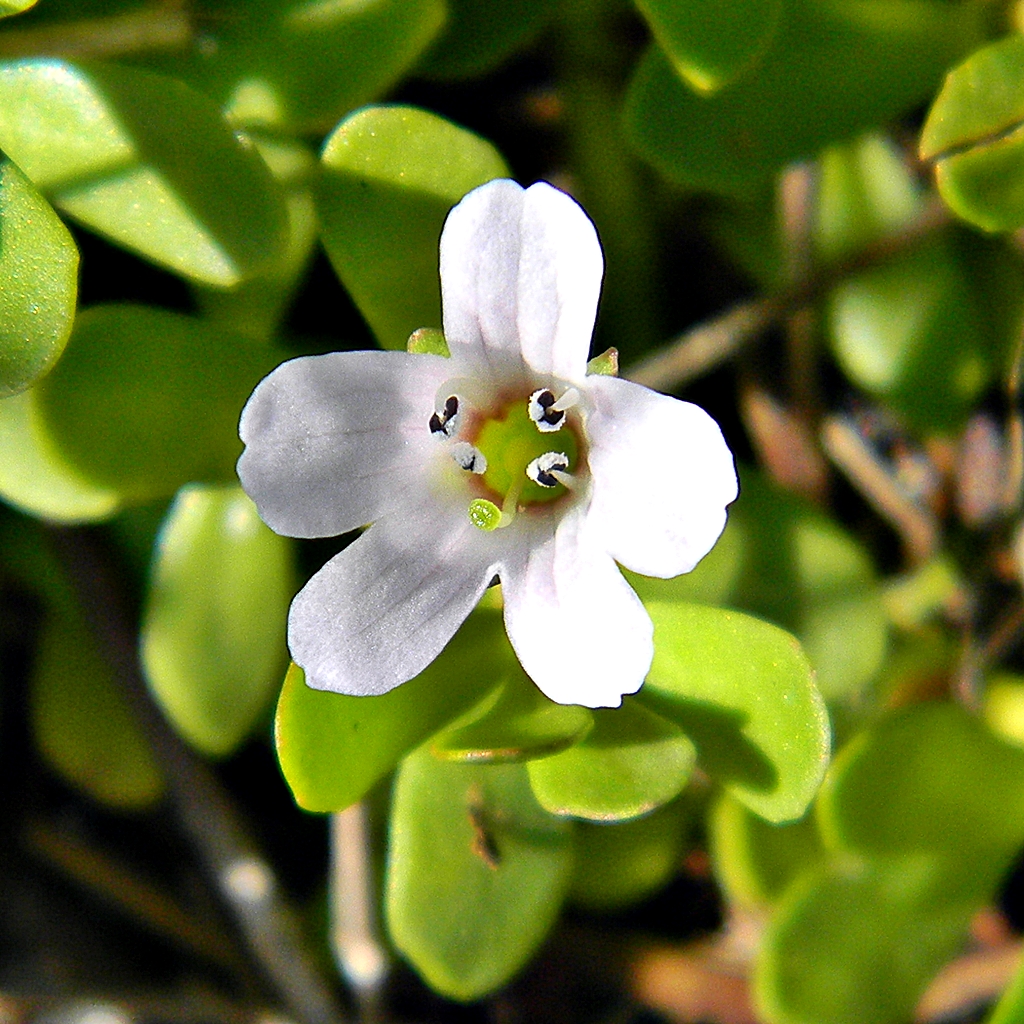
Bloom Period
Water Hyssop blooms during the warmer months, typically in late spring through early fall. The small purple or white flowers appear in clusters, usually at the ends of stems, adding a gentle splash of color to wetland landscapes.
Water Hyssop Flower Color
The flowers are small, with five petals that are light purple to white, with a distinct yellow center. They are funnel-shaped, making them attractive to pollinators.
Wildlife Value
Water Hyssop attracts a range of wildlife, particularly pollinators. Its small, delicate white or pale blue flowers are a favorite nectar source for native bees, including Honeybees (Apis mellifera) and various species of bumblebees. The flowers also attract butterflies such as the Common Buckeye (Junonia coenia) and the Pipevine Swallowtail (Battus philenor).
The plant’s dense growth provides habitat for small aquatic insects, such as water striders (Gerridae), which utilize the surface of the water. Additionally, Water Hyssop offers shelter for amphibians like frogs and small fish in wetland areas. It plays a key role in supporting local ecosystems by providing food and cover for these species.
13. Golden Creeper (Ernodea littoralis)
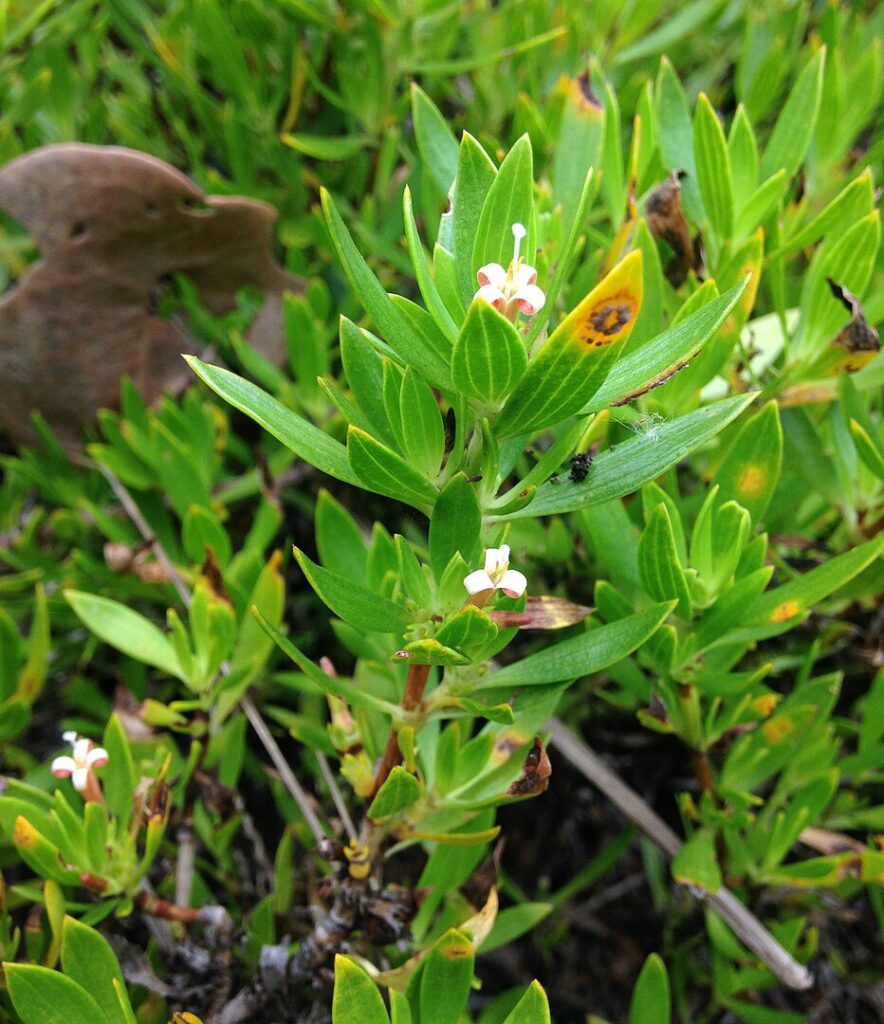
Golden Creeper is a low-growing, mat-forming perennial that thrives in coastal areas, particularly in sandy soils. It has small, glossy green leaves that are arranged in opposite pairs along the stems.
The plant is known for its delicate clusters of tiny, pale yellow flowers that bloom in the warmer months. It forms dense ground covers, helping to stabilize sandy soils and prevent erosion, making it an excellent choice for coastal gardens and dune restoration projects.
Best Growing Region / Zone
Golden Creeper is suited for Florida’s coastal regions and thrives in USDA hardiness zones 10a to 11. It grows best in sandy, well-drained soils, particularly in coastal habitats such as dunes and beaches.
Golden Creeper Preferred Growing Conditions
This plant prefers full sun and well-drained sandy soils. It is highly tolerant of salt and drought, which makes it ideal for coastal landscapes that experience occasional saltwater exposure and strong winds.
Golden Creeper thrives in areas with minimal water and can tolerate dry periods once established. It is also moderately tolerant of light shade, especially in the hotter parts of Florida.
Height / Spread
Golden Creeper typically grows to a height of 6 to 12 inches, with a spreading habit that allows it to cover areas 2 to 3 feet wide. It forms a dense groundcover, making it an excellent choice for stabilizing sandy soils and covering large areas.
Golden Creeper Lifespan
This plant is a perennial, which means it lives for several years in suitable conditions. While it may exhibit some dieback during colder months, it regenerates each spring from its root system.
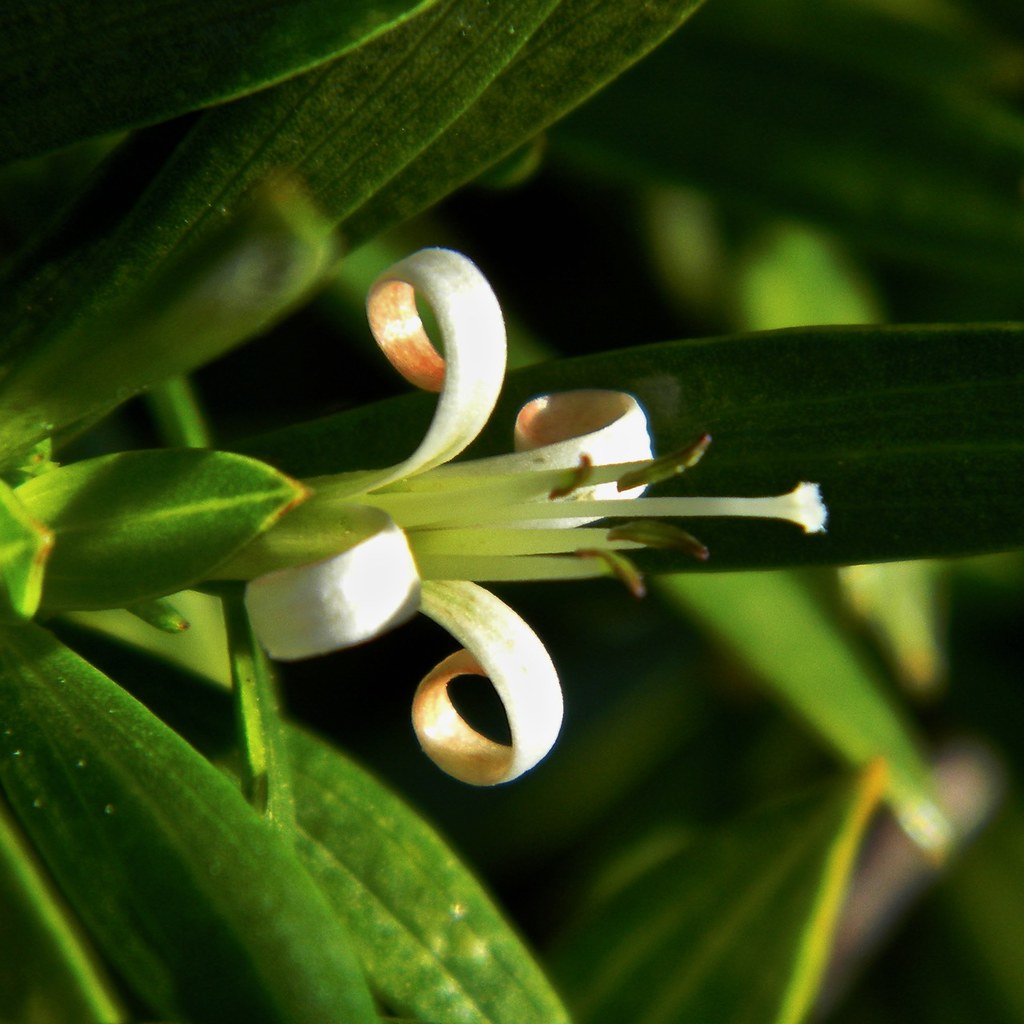
Bloom Period
Golden Creeper blooms from late spring through summer, producing clusters of small, pale yellow flowers. These blooms attract a range of pollinators and create a cheerful groundcover during the warmer months.
Golden Creeper Flower Color
The flowers are small and pale yellow, forming dense clusters. While the individual flowers are quite modest in size, the plant’s overall display is eye-catching and adds a subtle charm to coastal gardens.
Wildlife Value
Golden Creeper is an important plant for local wildlife. Its flowers provide nectar for various pollinators, including native bees, such as the Gulf Bumblebee (Bombus pensylvanicus), and butterflies like the Common Buckeye (Junonia coenia).
The plant also provides cover for small insects and wildlife that seek refuge in coastal environments. The dense growth habit helps protect the soil from erosion, and its flowers are an important food source for nectar-feeding insects.
14. Lemon Bacopa (Bacopa caroliniana)

Lemon Bacopa is a low-growing, spreading perennial that thrives in moist, well-drained soils. It has small, oval, bright green leaves that exude a lemony fragrance when crushed, hence the common name. This plant produces small, light blue to white flowers with yellow centers, which bloom sporadically throughout the year.
Its creeping habit makes it an excellent groundcover for both wetland and upland areas. Lemon Bacopa is often found in natural settings like wetlands, boggy areas, and along stream banks, where it adds a soft, lush appearance.
Best Growing Region / Zone
Lemon Bacopa is well-suited to Florida’s wetland and coastal regions, thriving in USDA hardiness zones 8a to 11. You’ll find it n areas with consistently moist soils, such as along streams, ponds, or wetlands.
Lemon Bacopa Preferred Growing Conditions
This plant prefers full sun to partial shade and grows best in moist, well-drained soils. It is highly adaptable to wetland environments, tolerating both standing water and drier conditions once established.
While it thrives in moist areas, Lemon Bacopa tolerates brief dry spells and is known to survive in pond edges, wet meadows, and ditches. It is not particularly drought-tolerant, so consistent moisture is important, especially in the warmer months.
Height / Spread
Lemon Bacopa typically grows 4 to 6 inches in height, with a spread of 2 to 3 feet. Its spreading nature makes it ideal for ground cover or for planting in hanging baskets, where its cascading stems can drape over the sides. It forms dense mats that help retain moisture in the soil while adding beauty to the landscape.
Lemon Bacopa Lifespan
This plant is a perennial in Florida, living for several years in suitable conditions. It is not typically invasive but will spread steadily over time, providing a lush, green mat.
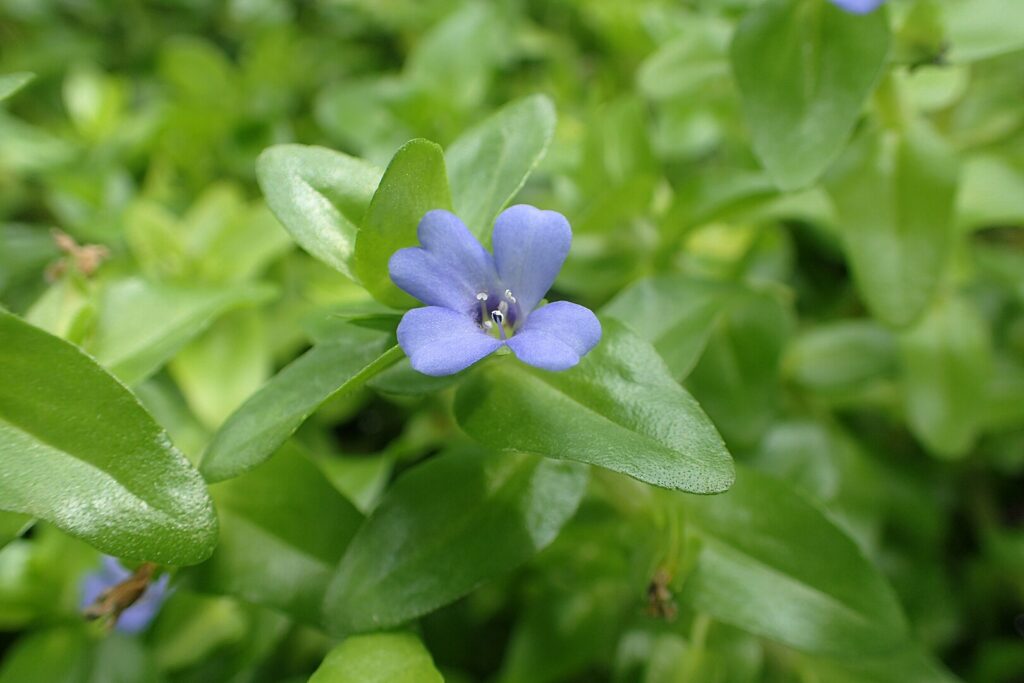
Bloom Period
Lemon Bacopa blooms from late spring through early fall, producing small, white to light blue flowers. The blooms appear in clusters, adding color to wetland and garden areas during its blooming season.
Lemon Bacopa Flower Color
The flowers are small, light blue or white with yellow centers, creating a delicate and attractive contrast against the plant’s green foliage. The blooms are not showy, but they add a soft touch to its overall appearance.
Wildlife Value
Lemon Bacopa is beneficial to local wildlife, particularly aquatic and wetland species. Its flowers attract a variety of pollinators, including native bees and butterflies. The plant is a valuable food source for nectar-feeding insects such as the Variegated Fritillary (Euptoieta claudia) and the Gulf Fritillary (Dione juno).
The dense foliage offers shelter for small wildlife and insects, and its growth habit helps stabilize the soil along water edges, preventing erosion.
15. Pink Purslane (Portulaca pilosa)
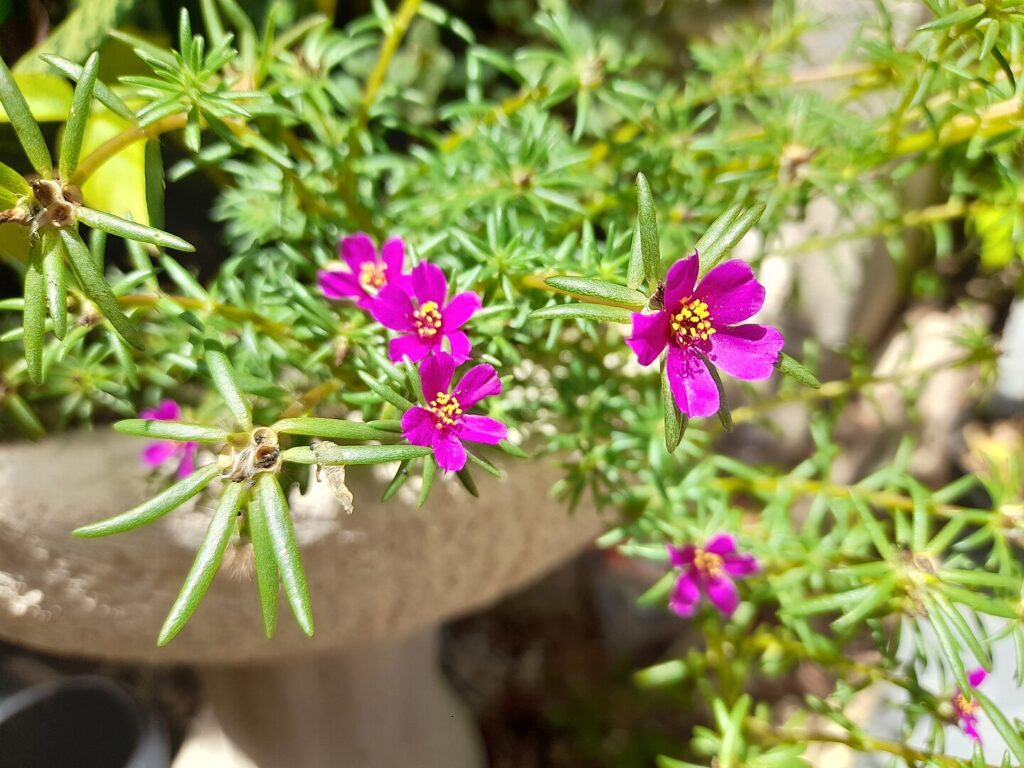
Pink Purslane is a low-growing, succulent groundcover that forms dense, spreading mats. It has fleshy, smooth, oval leaves that are light green to reddish in color. The plant produces small, vibrant pink flowers that open in the morning and close by afternoon. These blooms are cup-shaped with five petals, providing a colorful contrast to the green foliage.
Pink Purslane is known for its ability to tolerate dry conditions, making it an excellent choice for xeriscaping or low-water gardens. It thrives in sandy or well-drained soils and is ideal for areas where other plants might struggle to grow.
Best Growing Region / Zone
Pink Purslane is well-suited to Florida’s warmer regions, thriving in USDA hardiness zones 8a to 11. It is commonly found in coastal areas, sandy soils, and disturbed sites where other vegetation may be sparse.
Pink Purslane Preferred Growing Conditions
This plant thrives in full sun and well-drained, sandy soils. It is highly drought-tolerant, making it ideal for xeriscaping, dry landscapes, or areas with minimal rainfall.
While it can tolerate some shade, Pink Purslane performs best when it receives plenty of sunlight throughout the day. It is well-suited to areas with poor soils, and once established, it requires very little water, making it a low-maintenance groundcover option.
Height / Spread
Pink Purslane typically grows to a height of 3 to 6 inches, with a spread of 12 to 18 inches. Its spreading habit makes it an excellent choice for groundcover, filling in gaps between other plants or covering barren areas of soil. It forms a dense mat that can help suppress weeds and retain soil moisture.
Pink Purslane Lifespan
This plant is an annual in Florida, completing its life cycle in a single growing season. It may reseed itself in favorable conditions, but it does not persist beyond one year.
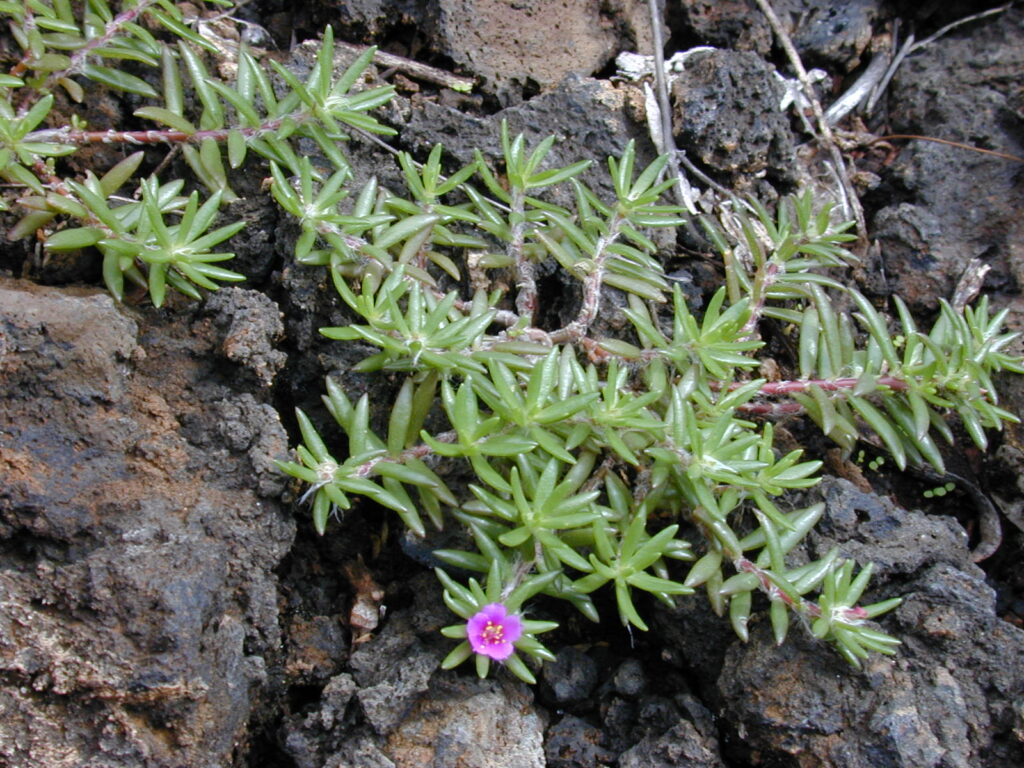
Bloom Period
Pink Purslane blooms from late spring through the summer, producing a continuous display of pink flowers. The blooms open in the morning and close by afternoon, offering a brief but beautiful show of color each day.
Pink Purslane Flower Color
The flowers are vibrant pink with yellow centers, adding a pop of color to gardens and landscapes. The petals are narrow and the blooms are typically 1 to 2 inches in diameter.
Wildlife Value
Pink Purslane supports a variety of pollinators, including bees and butterflies. While it does not provide significant food or shelter for wildlife, its flowers are attractive to nectar-feeding insects, such as the Eastern Tiger Swallowtail (Papilio glaucus) and honeybees.
The plant’s dense mats can help provide ground-level cover for small insects and other invertebrates.
Why Choose Native Plants for Groundcover?
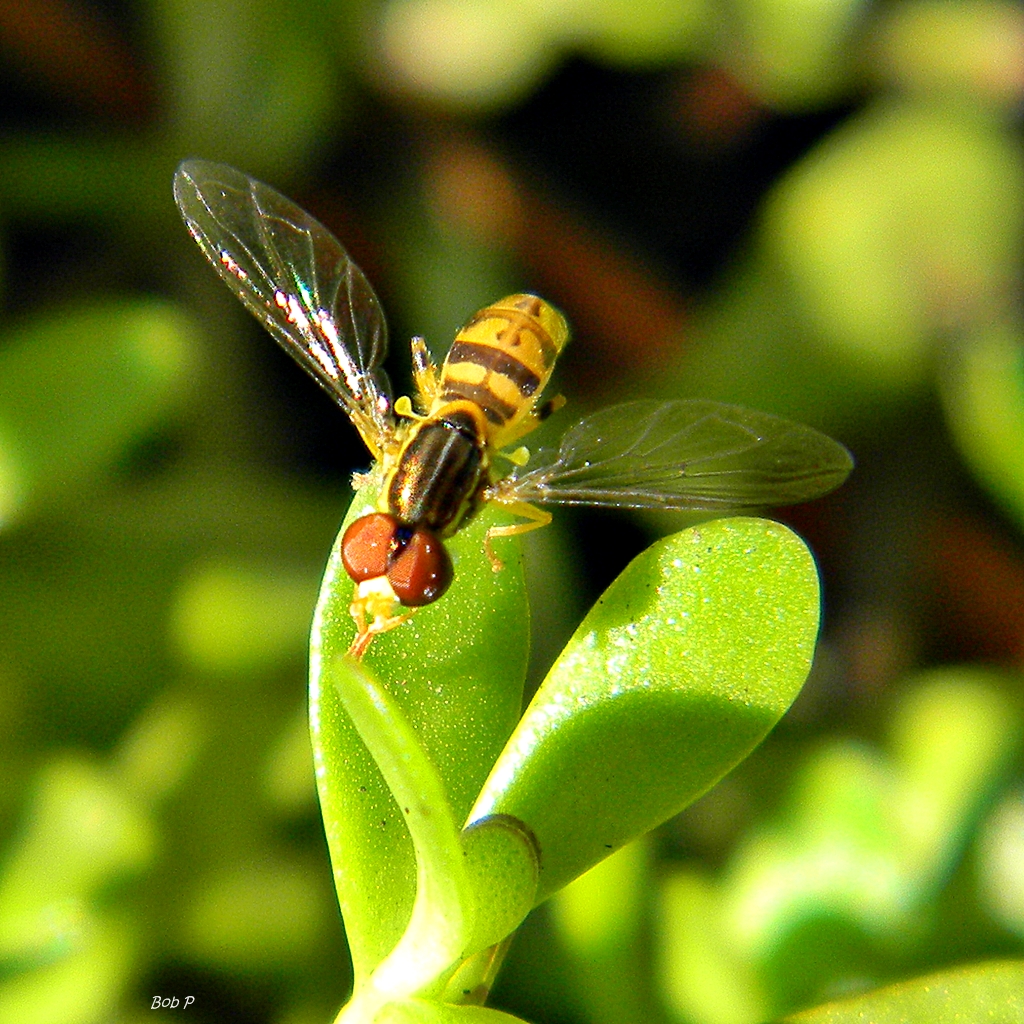
Native plants have evolved alongside Florida’s unique climate and conditions for thousands of years, making them perfectly adapted to thrive here with minimal intervention.
These natural survivors offer numerous advantages:
- Water Conservation: Native plants have developed natural mechanisms to survive Florida’s rainfall patterns, requiring less supplemental irrigation once established.
- Low Maintenance: Having adapted to local conditions, native plants typically need less fertilizer and fewer pesticides than non-native species.
- Wildlife Support: Local wildlife depends on native plants for food and shelter. By incorporating native species, your garden becomes a vital habitat for butterflies, birds, and beneficial insects.
- Climate Resilience: Native plants can better withstand Florida’s extreme weather conditions, from intense heat and humidity to occasional freezes.
- Soil Health: These plants have evolved to work with local soil conditions and often help improve soil quality over time by offering host to local microbiology.
Strategic Use of Groundcovers in Your Garden
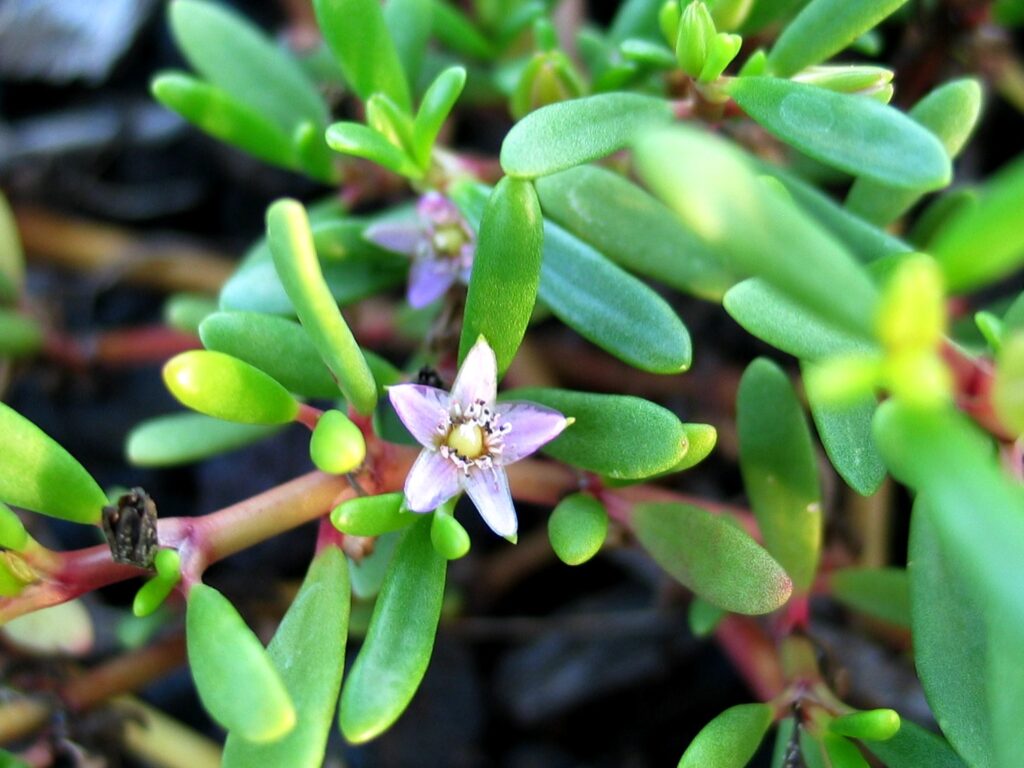
When incorporating native groundcovers into your landscape, consider these key placement strategies:
- Under Trees: Use the Florida native ground covers for shade beneath trees where grass struggles to grow. They won’t compete with tree roots and can create attractive woodland gardens.
- Slope Stabilization: Plant groundcovers on slopes or banks where erosion control is needed. Their root systems help hold soil in place.
- Border Enhancement: Use them to soften hardscape edges and create natural transitions between different garden areas.
- Lawn Replacement: Consider replacing high-maintenance turf areas with native groundcover species, especially in shady spots or areas difficult to mow.
- Between Stepping Stones: Plant low-growing natives between pavers or stepping stones to create charming garden paths.
Remember to group plants with similar water and light requirements together for optimal growth and easier maintenance.
Bringing Your Landscape All Together with Native Groundcover Plants
Creating a Florida garden with native plants, especially groundcovers, is an investment in both beauty and sustainability. These plants offer practical solutions to common gardening challenges while contributing to the broader ecosystem. By choosing natives, you’re not just creating a beautiful garden – you’re supporting local biodiversity, conserving water, and preserving Florida’s natural heritage for future generations.
As you select plants for your garden, consider how different native species can work together to create a landscape that’s both beautiful and resilient. With proper planning and plant selection, your native Florida garden can become a low-maintenance oasis that connects your outdoor space to the natural world around us.



